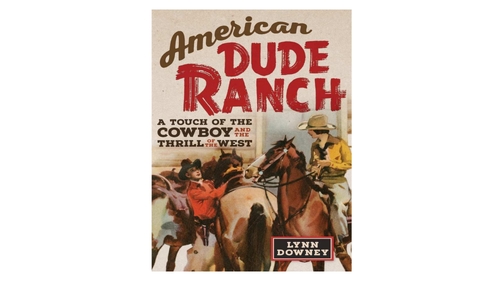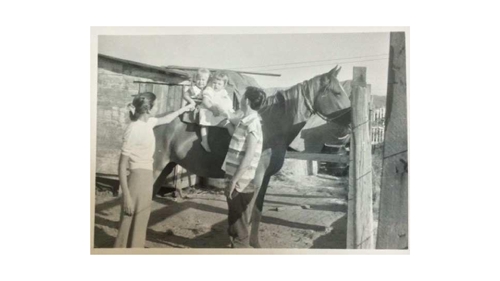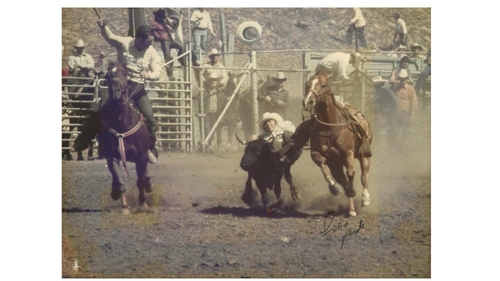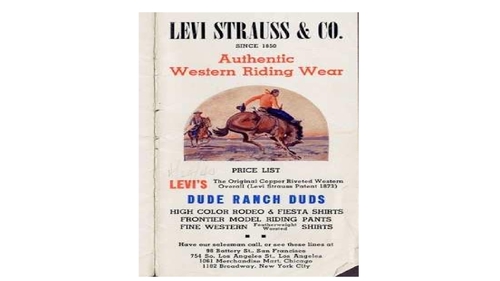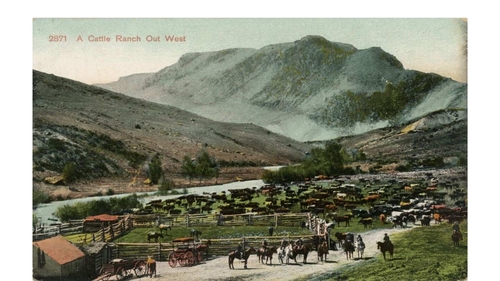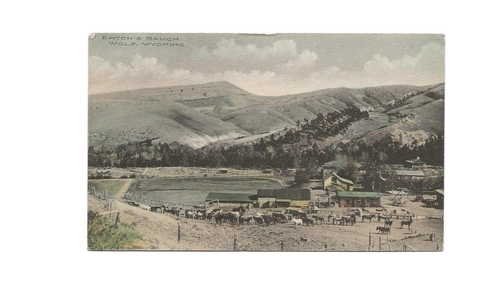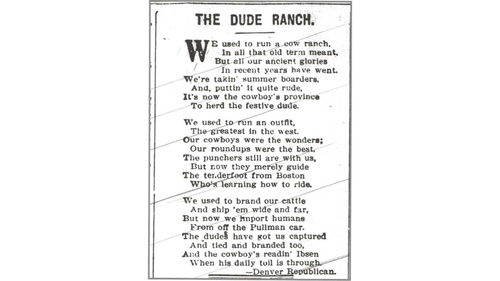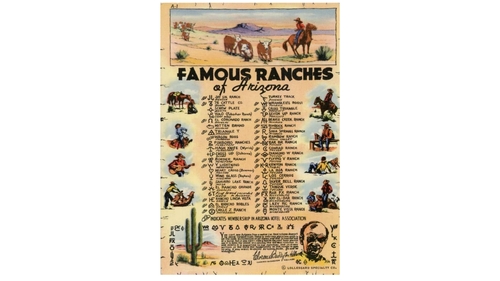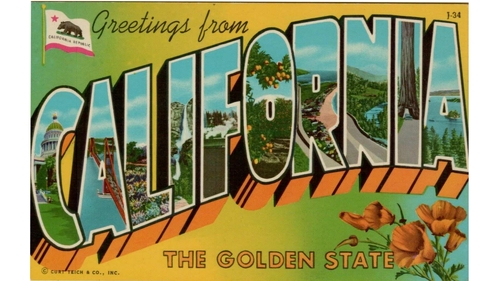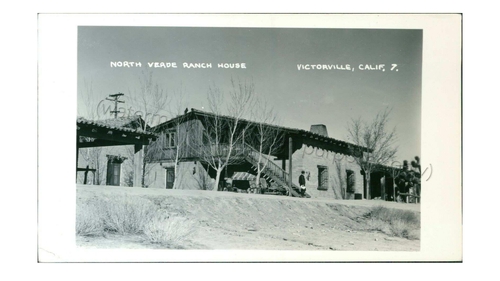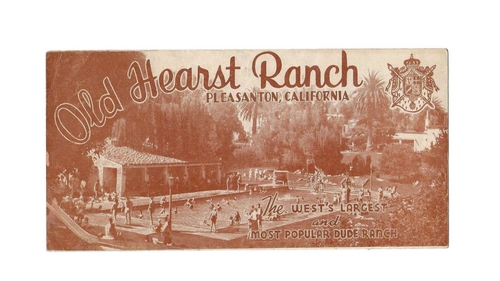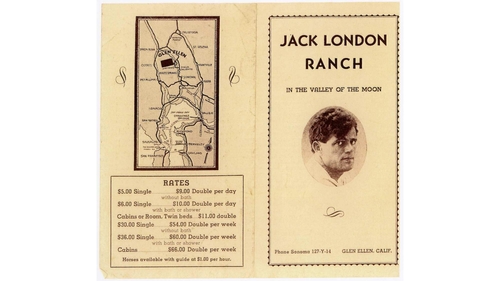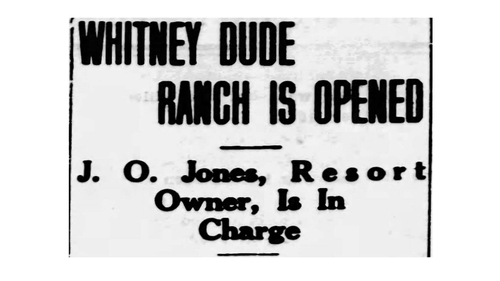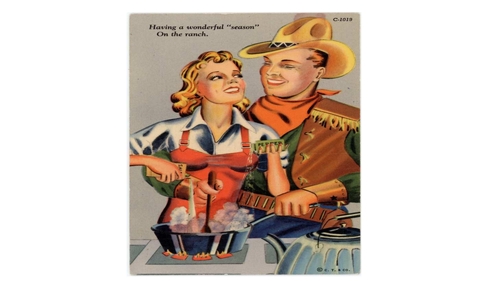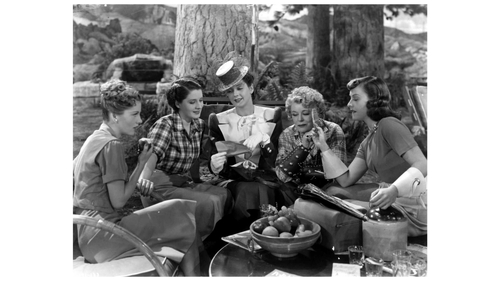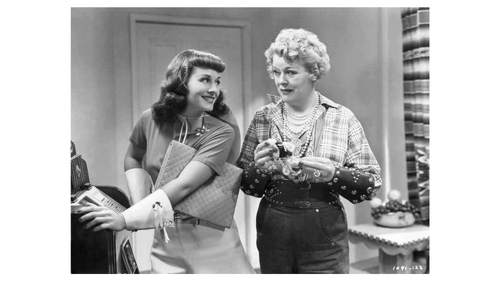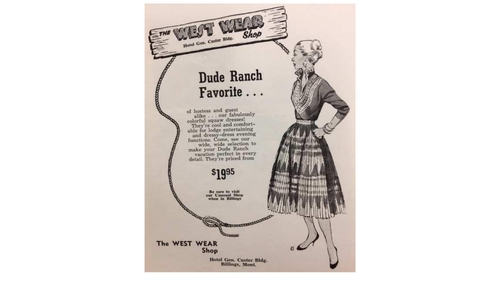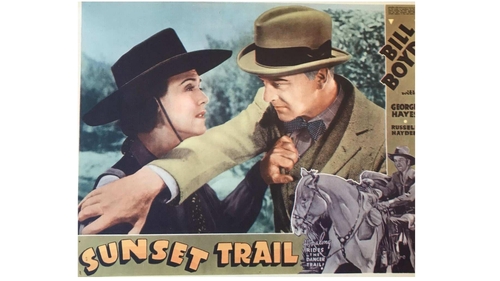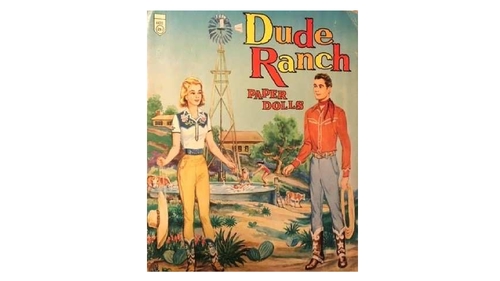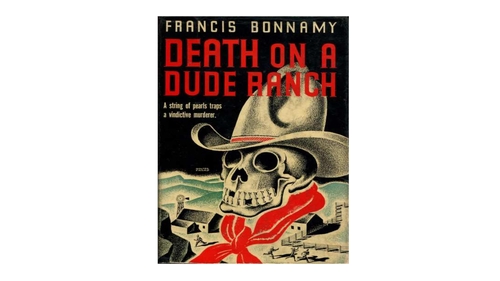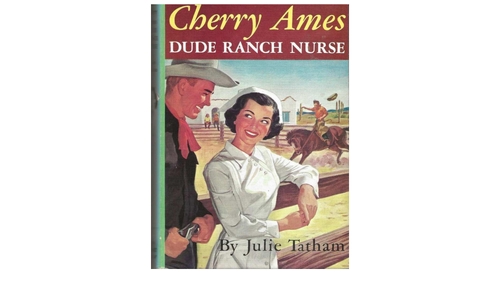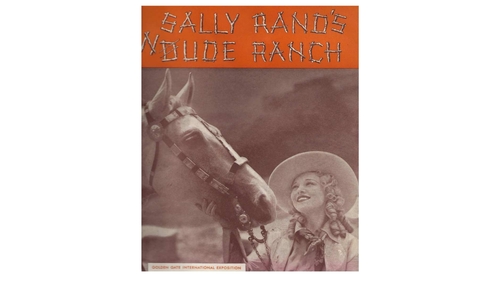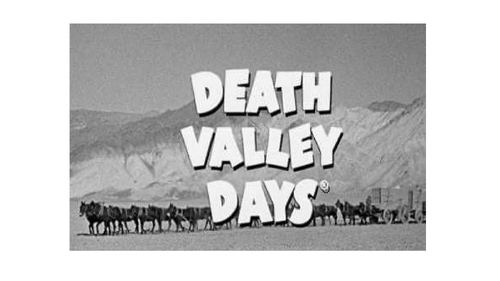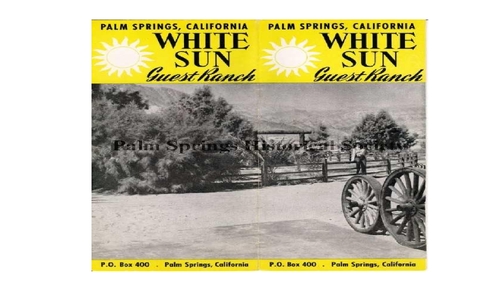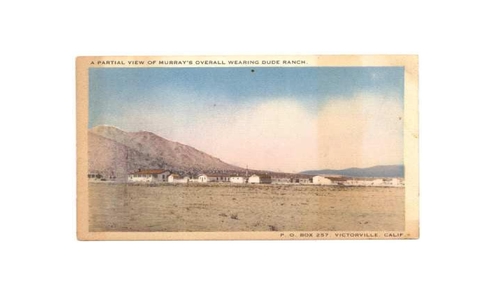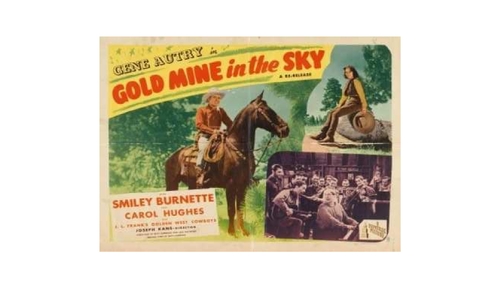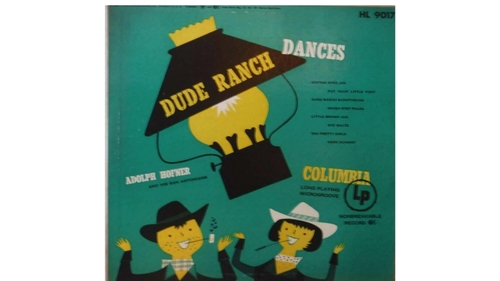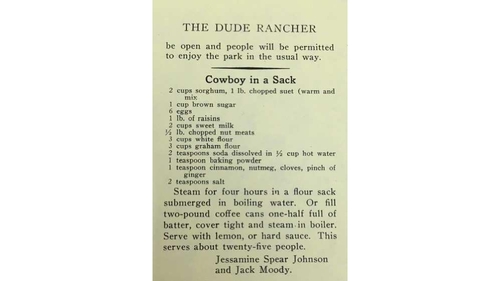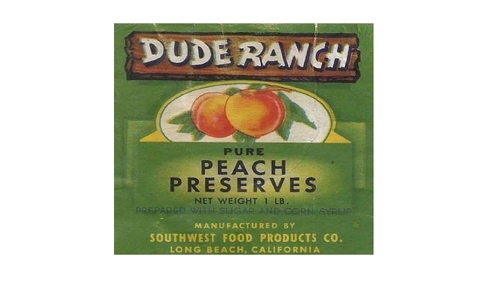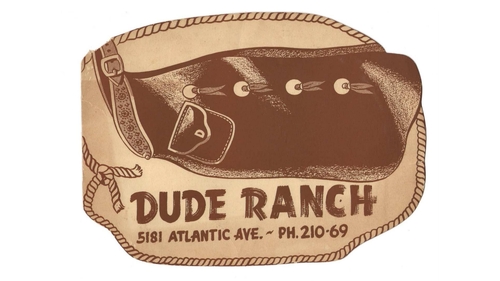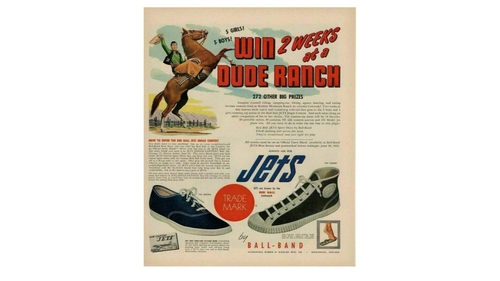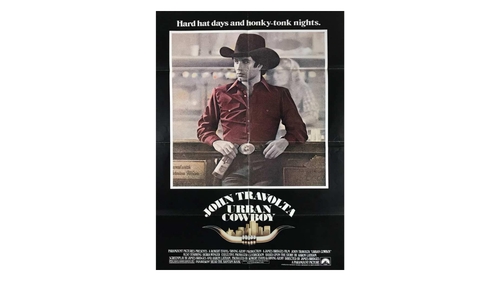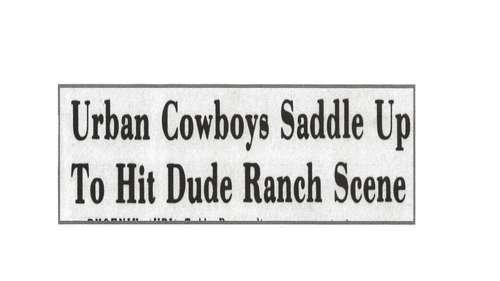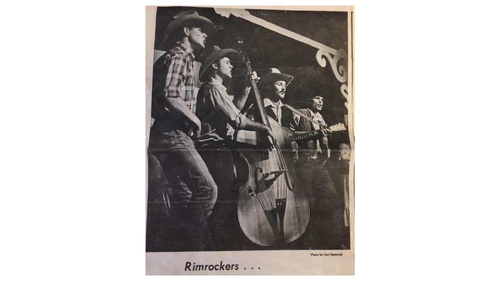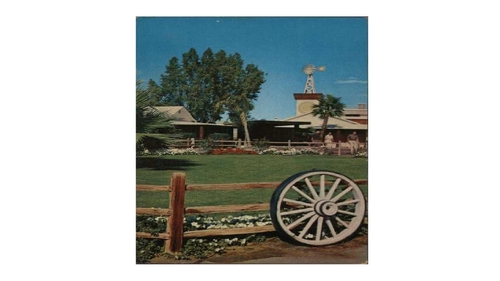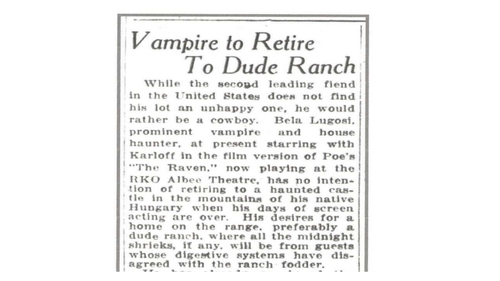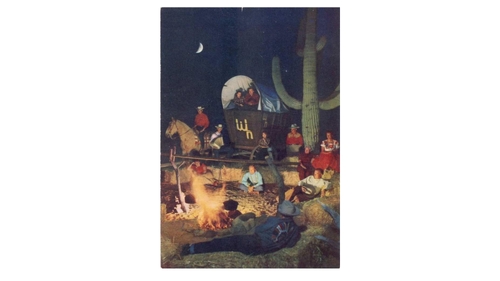Enter a name, company, place or keywords to search across this item. Then click "Search" (or hit Enter).
Collection: Videos > Speaker Nights
Video: 2023-08-18 - American Dude Ranch: A Touch of the Cowboy and the Thrill of the West with Lynn Downey (64 minutes)
Nevada County Historical Society is pleased to present Lynn Downey who is an award-winning historian, novelist, and consulting archivist. With an introduction by author Chris Enss.
Lynn’s presentation is about her latest book, American Dude Ranch: A Touch of the Cowboy and the Thrill of the West (on Amazon), which came out in 2022. Lynn gave lectures about the book at the Buffalo Bill Center of the West in Cody, the Rockmount Ranchwear clothing store in Denver, at the Angeles Camp Museum here in California, and in many venues around the state of Arizona. She will talk about the fascinating and sometimes hilarious history of the dude ranch, and will also show slides of historic places, people, and advertising.
Lynn’s presentation is about her latest book, American Dude Ranch: A Touch of the Cowboy and the Thrill of the West (on Amazon), which came out in 2022. Lynn gave lectures about the book at the Buffalo Bill Center of the West in Cody, the Rockmount Ranchwear clothing store in Denver, at the Angeles Camp Museum here in California, and in many venues around the state of Arizona. She will talk about the fascinating and sometimes hilarious history of the dude ranch, and will also show slides of historic places, people, and advertising.
Author: Lynn Downey
Published: 2023-08-18
Original Held At:
Published: 2023-08-18
Original Held At:
Full Transcript of the Video:
I know that you're going to enjoy the speaker. This is Lynn Downing's night. Lynn Downing is an accomplished award-winning author. She spent many years working for Levi Strauss and their archives department. So she's just a wealth of knowledge about, if you've got any chainsaw tonight, she'll be able to spot something in stores or nothing. But I mean, she's really, she's just brilliant. She's also the current president of Women Writing the West. And it's a wonderful organization. And Lynn's book, as you can see here, American Dude Ranch, it's a wonderful book. And she brought a few copies that are in the back. And after she gets done, you want to run, not walk, to get a book. They are $20 each. And I'll be back. They're holding, you know, just give me this sign if you want to say one. And I'll go on a side for you. But you're going to enjoy hearing from Lynn. So Lynn, please come and take it away. Thank you. [applause] What an introduction. That's the best introduction I ever got. Thank you, Chris. And thank you all. Look at all you Thursday night history books. Wow. I am just thrilled to see all of you. Thank you all so much for coming out and letting me jot at you about my favorite topic. So I'm going to talk a little bit about how I came to the topic of Dude Ranging. And one that I came as sort of backwards. I come from a very horsey family. The freaked out blonde on the back of ginger hair is me. My uncle raised quarter horses in his backyard in Elso Brandi in the '50s and '60s when you could still do that. My husband Chuck there on the right, he was a very horsey person. This is what he did later in his life. He rodeoed. He was a bulldogger and a calf roper on the rodeo circuit. I did not get the horse gene. I got the love of Western history gene. So when I was hired in 1989 to be the first historian for Levi Strauss and Kup in New San Francisco, it was a wonderful, an amazing opportunity. My family formed Levi's genes for 100 years. And as an archivist, I got to start the archives up. And when I first started going through the material that survived the earthquake and fire, I came across this catalog from 1938 called "Dude Ranch Duds. " And I thought, "How the heck is this?" And what it was was a catalog full of the regular jeans and jackets, but satin rodeo shirts with contrasting piping and side zip, gabbardine pants, and, you know, fancy schmancy Western clothes. And I thought, "Clothing just to wear on a dude ranch?" Well, that's sort of new. I mean, I knew what a dude ranch was. So I began to read a lot about dude ranching, partly for my job, but partly because it just was a fascinating concept to me. And then I started, about 10 years ago, I started collecting dude ranch memorabilia. Now, I'm not obsessed or anything, but I have about 100 pieces of dude ranch memorabilia in my house, on my walls. So what really fascinated me about the dude ranch is it's sort of the original Western buckaroo vacation. And it has no parallel anywhere else, either in this country or overseas. It's a very unique kind of vacation. And this year, dude ranching is 141 years old. I know we think about dude ranches, "Oh yeah, they've been around since the days of the Gee and Audrey or whatever. " But they did that much, much further. So you can't have anything called a dude ranch without ranches. And they really got their start in the Rocky Mountain West in the 1870s and 1880s. So a lot of men were coming from back east and starting up cattle ranches. And it was sort of the custom that if any man who came through your area and he needed a place to stay or something to eat, you would host him. Because if you're in, you know, Madora, North Dakota, where we'll be in a moment, there are no hotels. There's no places for these people to stay. And a lot of these men are rich English and Irish lords who have come out to shoot interesting American animals in the Rocky Mountains. So they're staying at the cattle ranches owned by these people. So among these first ranchers were the Eats brothers of Pittsburgh, the three Eats brothers. They started the Custer Trail cattle ranch outside of Madora, North Dakota, which is on the Little Missouri River. Theodore Roosevelt had his Maltese cross ranch very nearby and actually would visit with the Eats. So they got their cattle ranch up and running, and they're feeding and housing these guys that are coming from back east. And one day they looked at each other and they said, "We're losing money on these guys. What are we doing?" So they put out a guest book in 1882 and started charging $10 a week for these guys for food and logic. And word got out, and the Eats brothers themselves put out the word as well. More and more men started to come and they realized they created sort of a new industry. And it didn't take long for them to really sort of begin what dude ranching really was. So the concept was that not only would you come from the east to maybe be a hunter, maybe you didn't hunt. Maybe you wanted a real cowboy vacation. You wanted a cowboy experience. So another thing that was going on in the 1880s is a lot of worried, wealthy parents back east that are watching their sons, drinking too much and living in riotous lifestyles, they would pour their sons on the train and send them out to North Dakota to stay on the Eats Ranch where they could like man up and cowboy up. What a lot of the guys at the Eats Ranch know is how many bottles of booze were hidden in the crotch of the trees and into the ranch because they were going to Little Tom's Saloon in Madora, but that's okay. So there was this idea that if your manliness is being threatened, you can just go to this ranch in North Dakota and change your life. Change your life, have a real cowboy life. So by the end of the 1890s, a new word had come up about in American society called the dude ranching. Now, this is a whole poem from about 1912, it's a little bit later, about how real cowboys were sort of de-ploring the fact that they're sort of herding dudes instead of cows now. My very favorite line is the last two lines in the first stanza, "It's now the cowboy's problem, it's to her the festive dude. " I wanted that to be the title of my book, but the publisher wouldn't go for it. So the dude ranch, it was starting to be called the dude ranch because the word dude had also been around since the 1880s. It's actually a very old northern English word, the word was dudus, that in America became the word duds, meaning clothing. So dude ranch duds. And then somehow, and even people who study word origins don't even know how this happened. The word dude derived from this dudus and then duds, and it meant a man who wore fancy clothing. So kind of a boat rumble, kind of a dandy in the 1880s. And the other thing that was happening in the 1880s was these sort of waves of immigrants were coming into the east, and a lot of people were freaking out about all these not white, not Protestant people who were sort of taking over our country. Doesn't that sound familiar? And so people felt that American manhood was being threatened, and these dudes were threatening. Anybody who was not very manly was called a dude, and it was a pejorative. And there was a, oh, come on, what year was this? In 1883, there was this line in a North Dakota paper. The dudes of Butte wear plug hats. One cowboy festival will deal with that right away or something like that, and men were wearing bowler hats. That was just a little, two-way family. And it took a cowboy to put a dude in this place. So the dude ranch was becoming this kind of place where you could get that infusion of American manhood. And again, people are still sending their sons out there. And by the years before World War I, it wasn't just men going to dude ranches. It wasn't just single men and hunters. Suddenly, families were going, husbands and wives, and children were going to these places because it became the kind of-- it was an outdoor vacation. There was always horseback riding. And the cowboy was firmly entrenched as this American cultural icon. Cowboys had begun their lives as outlaws. The cowboys around Tombstone, Arizona, they were the bad guys. But by the late 1890s and early 1900s, the cowboy was the hero of the world. And so you're going to these dude ranches, and you're going to be around cowboys. And you're going to take that little bit of that cowboy life back home with you. So the ranches were really only open to talk about Montana and Wyoming. And actually, the Eaton brothers, by about 1903, they realized, forget the cattle business. We're going to start the dude business. And they moved to Wolf, Wyoming and opened Eaton's dude ranch in 1904. And it is still in business today in the same ranch. So Montana, Wyoming is where you're seeing a lot of these ranches. But nobody goes to a dude ranch in Montana in January. Some places like Arizona and New Mexico are like, hey, we can open dude ranches. People come here in January and February. And yes, they were right. And Arizona actually became one of the biggest locations of dude ranches before World War I. And ranches saw a lot more activity around the years of World War I, because rich people back east who were used to going to Europe on vacation could not go there between 1914 and 1918, because those were the years of World War I. So instead of looking east to Europe, they looked west to Montana, Wyoming, and eventually Arizona to have a really wonderful vacation. And what's fascinating to me-- and I still sort of can't wrap my mind around this-- the first visitors going to dude ranches were wealthy people. It was a pretty expensive vacation. Wealthy Easterners who were coming out west, these were people who were used to buying sheets and fine hotels and wonderful service. And they're coming out to Arizona and Montana. And they're living like they're campers. They're living in rusty cabins. And they're not sleeping on fine sheets. And they're loving every minute of it. And I've had other dude ranches tell me what was the contrast to their real life. But there was just this sense that they're having this real American vacation. But I just might not pass. Well, one thing that really got the dude ranches up and running was the railroads. They collaborated very closely with railroads. Because railroads knew they had a lot more money with tourists than they do with freight. So by the early 1920s, railroads in the Northern Pacific, up north, and Santa Fe, and southwest, started printing out these really beautiful brochures. But one entire brochure about every dude ranch that you can get to on that specific railroad line. And every single entry in these brochures is this is the name of the dude ranch. This is the train. You took the train station. You get off. This is how much it will cost. It was incredibly detailed. Dude ranches, some of which were so remote that you made, they'd come and pick you up with a train. And it would be a 45-minute car ride out to the middle of nowhere to go to the dude ranch. Dude ranches could not have flourished without the railroads, without the advertising, the free advertising that they got from these railroads at this time. California was not a big dude ranch area. It really wasn't. There were a few around Palm Springs. But there were a few with some very interesting stories. The area of Victorville, north of San Bernardino, was actually kind of a dude ranch hub. There's a very interesting story about this one, the North Verde dude ranch. Because movie history was made here in 1940. Orson Welles sent screenwriter Herman Mankiewicz to the North Verde ranch to write the first draft of Citizen Kane. Now, Mankiewicz had a grown leg. And you couldn't get into town to get the amount of alcohol that you usually had. But he managed. And he did write the first draft of Citizen Kane at this very dude ranch. Now, Citizen Kane is, of course, the very, very, barely concealed story of William Randolph Hearst. And there's even a William Randolph Hearst dude ranch collection. Phoebe Averson Hearst was William Randolph Hearst's mother, California's greatest philanthropist. And she had a house in Pleasanton, east of San Francisco. And she died in 1919. And then William Randolph Hearst inherited the property. And he sort of lived there for a while. But then he eventually took all of the antique art out of the building and sent them down to San Sineo. Did his beautiful grand home there. And then he sold the property in 1924 to a group of investors who turned it into the Castlewood Country Club. Then the Country Club people gave it up in about 1940. And it became the old Hearst Ranch in Pleasanton. It was always full. And it was not a traditional dude ranch, because you could just sort of drop in and have a meal, or drop in and have a horseback ride. But it was really popular. Every Sunday for years, they had the dude ranch breakfast radio show that they would have outside the front of the ranch. And then in 1952, it was sold, and is again, the Castlewood Country Club. So I'm going to backtrack a minute. So the difference between a dude ranch and a hotel is very big differences. One of which is, you go to a hotel. You get a room. You don't know who the manager of that hotel is. You certainly don't know who the owner is. And you don't even meet the manager unless you have a complaint. You go to a dude ranch. You're in that rancher's home. He and his wife, he and his wife and his kids, if he has children. You are in their home. Their house is right there. And that family, that couple, is involved in every activity that you do, from the trail rides, to the camp fires, to the chuck wag and lunches, everything. It is a completely immersive experience with this Western family. So it's very, very different. And the dude ranch model was, you have to make a reservation in advance. It wasn't like the new auto courts. You couldn't just drive up and have a room for the night and keep going. You have to make a reservation. And in the early days, people would stay for weeks, sometimes the whole season. Many dude ranches had schools on the property because if you were there for so long, you could send your kids to school. But that was the end of the American plan. It was one inclusive price for everything-- board, room, food, laundry, horseback, writing, everything. So it's a really, really big difference. It's a difference in business structure, and it's a difference in feeling. There's nothing hotel-like at all about a dude ranch. Now, in Sonoma County, where I live-- I live in Sonoma. And Jack London and his wife, Charmian, had a property in Glen Ellyn, which they called the beauty ranch. It's a beautiful, beautiful property. Jack London was what was called a scientific farmer. He put a lot of very modern farming practices into his ranch. And he died very suddenly in 1916 at the age of 40. And his wife and his sister stayed on the property. And about 1933, during the Depression, they're like, well, it's kind of expensive to keep this ranch up. So they turned the Jack London ranch into a dude ranch. And it was open until the middle of World War II. There were little cabins to stay in. You could bring your own horse. Many people didn't. They also had horses there that you could rent. And it was open until, well, I think about 1943. And even a lot of people in Sonoma County don't know this, but this is a picture of one of the brochures. Very reasonable prices, I think. I don't have an image for this, but there was a dude ranch north of Big Bear. It was a dude ranch for dogs. And Gladys Shipman opened this dude ranch for dogs. And it was kind of like when we have doggy daycare now. But it really was for people who needed to board their dogs for a long time. And it was more than a kennel. And a lot of Hollywood movie stars would board their dogs there. But the greatest thing about Gladys and her dude ranch for dogs, when Pearl Harbor hit, she opened up her dude ranch to dogs who belonged to service members who were in Hawaii and had to ship their animals and their families back to America. And so she would take in dogs of officers who maybe didn't even have any family. And she kept dogs for years for American military service men and women at her dude ranch in Big Bear until the war was over. I wish I could find Gladys's descendants. I want to say thank you for her dude ranch for dogs. So I tried to find out if there was a dude ranch anywhere near here. And I really couldn't, at least in the short amount of time that I had. However, there was one in Rockland. And it was the old-- I'll put my notes here-- Joel Parker Whitney mansion in Rockland that is long demolished. It was built-- oh, it was built-- 1884. And some people bought it in-- oh, what did they open? In 1936, a consortium of people bought it in 1936. They ran it as a dude ranch for about a year. But again, it wasn't a classic dude ranch. It was more like a sort of a Western ranch where you could ride and have dinner or whatever. But it was-- a lot of people by the 1930s found that using the word dude ranch to describe their business did a lot for their business. And we'll see that a little bit later. Advertising was very important to dude ranchers. So they had the railroads. They're making-- printing up those beautiful brochures. A lot of them printed up cards about their own dude ranch. But then the current Taish company of Chicago, which is the company that makes the famous readings from postcards-- I think I had the California one there-- that's a Chicago company. And in the late 1940s, they made a line of 10 called dude ranch comics postcards for dude ranches to hand out to people to sell them in their own internal stores or whatever. This is one of the creepier ones. [LAUGHTER] This one, I just-- it's really weird. And so it was-- they all had the same sort of face. And it was all about the kind of interesting things you could do on a dude ranch. But a lot of them have to do with the dude deans on the-- that's the female dude, by the way. It's not dudeette. It's dudeine, by the way. So there was sort of playing on this really popular trope of the dudeine from back east comes to a dude ranch, falls in love with the wrangler, and then marries him. So a lot of these cards show these really attractive looking women, and the cowards are drooling all over them. [LAUGHTER] But it was very-- this was really happening. I mean, I know-- but I found references that they're in my book of women who came out west and they married the wrangler. Nine times out of ten, those marriages didn't last. I'm surprised. [LAUGHTER] But what I love is how they're depicted in these cards, and they're so of their time. Women benefited very well from dude ranches in a very particular place, and that's the state of Nevada. In 1931, the state of Nevada did two important things. They legalized gambling, and they made it possible to get a quickie divorce in six weeks. And all you had to do was live within the borders of the state of Nevada for six weeks, and you could get your divorce. So people in Reno were really smart right off the bat, and they started opening these what were called divorce ranches. And you go and you live at this ranch, and you meet your lawyer once in a while in Reno, and maybe gamble, whatever. And then six weeks later, you go back to New York and get your divorce. And a lot of existing dude ranches started advertising, hey, come on, divorce ladies, come on, save us. And it was nine times out of 10 these women would come, and they would stay at these ranches outside of Reno. And really, you could stay anywhere in Nevada but Reno. It was just clusters of these ranches for these divorcees. So the greatest film depiction of this phenomenon is the 1939 film The Women, starring Joan Fontaine, Norma Sher, Rosalyn Russell, Mary Walden, and Pauline Goddard. So these are all wealthy New York women, and they all are getting divorces, and they're on the train for Reno, and then they stay at the Barthe Ranch, I think is the name of it, and run by Lucy, who's played by Marjorie Maine, a mock-hell of the mock-- in a mock-hell movie. So Rosalyn Russell actually shows up a little bit late, and she brought up to the ranch in this wagon, and she gets out of the wagon with this English saddle. And Lucy says, what's that dude contraption? And Rosalyn Russell says, send English saddle. I refuse point blank to learn to ride one of those Western things. And Lucy says, did you ever see a horse laugh? Well, you're going to. That really happened. Back in use who were excellent horsewomen had to learn to ride Western when they came out West, and some of them didn't like it, but anyway. So the other thing that women did, and what they did in the film, was they changed the way they dressed. So these women-- when they're in New York, they're in gowns by Adrian, right? And then they come out to the Barthe Ranch, and if you're a public goner, you're in white linen hot pants and white leather bums. If you're Mary Boland on the ride, you're in jeans, a plaid flannel shirt, five ropes of pearls, and a dying clip. And there's nothing wrong with that. What the signal was, these women are in alien territory, and they're in this transitional place. The dude ranch is this transitional place between their old married lives and their future divorced lives. So it has to be a place that's completely different from what they're used to. And it was a way for them to make that break, and they do that very well in the film. Movies and, eventually, TV also moved dude ranch clothing into the mainstream. So this is what is called the patio dress, or unfortunately, a squad dress, which is a very, very popular garment for women in the 1950s. And in the 1950s, a lot of suburbanites are having Western-themed dinners in their backyards, because the dude ranch has become this sort of cultural phenomenon, and they're taking this into the suburban life. And one way that that happened was through film. The very first movie that ever depicts a dude ranch is a silent from 1919 called Wrangling Dudes. And it's set on a Montana ranch. It's all lost to silent. I've found almost every movie that was ever made that features dude ranches, and I have not been able to find Wrangling Dudes. If you find Wrangling Dudes, you email him, since I really want to see this. But it was filmed in Montana. But then, eventually, dude ranching became part of the plot of regular films. So he sets a trail from 1939, same year as the women, Hopilon Cassidy has to solve a murder on a ranch, and he has to be incognito. So he dresses as a dude, and he's kind of a schlummy guy. And he's afraid of horses, and when he turned out to be a poker shark. But anyway, he has to dress incognito to be able to solve the crime. And then when the crime is solved, he gets back into his all black clothing and back onto his white horse, and he's Hopilon Cassidy again. Again, it's that thing where if you're a dude, and it's not really who you are, it's the perfect costume. It's the perfect secret identity. And lots of other films, the Chud open films, over and over again. And there were a lot of films in the 1950s about the divorce ranch, the Rocha Reno, Vacation in Reno, all kinds of films about that divorce ranch phenomenon. So as Moore families started going to-- this is from my collection. That's why I have paper dolls. As Moore families started going into dude ranches, especially after World War II, there was a lot more merchandise available. And so there's this whole book of paper dolls. I wear everything in this book, this clothes are adorable. And so you're seeing a lot more kids. You're seeing a lot more activities on dude ranches that are more for families at this time as well. A classic old-timey 1930s dude ranch. You ride horses all day. You have a Chuck Wagon lunch. You stay around the campfire. But then in the evening, everybody is together in the main lodge. They play cards. There's board games. There's always a piano. And so everybody's-- because it's another thing that's different-- is everybody's together in the evening after dinner at a dude ranch in that lodge being together. Friendships were formed at these dude ranches that lasted for decades. I've met people who met friends at dude ranches for 25 years still go together to the same dude ranch, to be together. That's what these dude ranches fostered among its guests. More cars. So more people are driving cars after World War II, obviously, so they don't necessarily have to take the train to get picked up. So they can drive to the dude ranch. But they're still there for the duration for that vacation. Dude ranching moved into literature. The very first novel ever written about dude ranching was called The Dude Wrangler, 1921. And so it started showing up more and more in books. And so Mystery Novel-- this is from 1939 or so-- Mystery Novel, sit-out on a dude ranch. Then there are the sillier books. They're Jerry Ames, dude ranch nurse. Jerry Ames was the Nancy Drew of the nursing world. And she would go from family to family and solve their problems and solve mysteries. So in this one, she goes to a dude ranch in Tucson. And the family has-- somebody died, and they're trying to find the will. And I remember what goes on. But my favorite thing is the cover. Because here she is at this ranch. And she's in this pristine white-- [LAUGHTER] And there's the guy in the fucking bronco behind you. You know that life's five minutes. I don't even want to know what her shoes look like. But you know what? That's OK. This is how dude ranching is showing up, as you're moving from solid films to films to literature. And it's very funny. So I would be remiss in my responsibility as a historian if I did not tell you about Sally Rand's nude ranch. [LAUGHTER] Sally Rand was a burlesque dancer. She was a fan dancer in the '30s. In 1933, she-- 1935. 1935. She debuted an attraction at the Fort Worth Centennial called Sally Rand's nude ranch. What this was was you would pay your dime or your quarter or whatever. And you'd go in. And there would be this sort of faux Western setup, sort of a faux Western building. You'd go through the door. And behind it would be a movie set that looked like the desert. And frolicking through this were women who were wearing pistols and holsters and boots and hats. And that's it. [LAUGHTER] Maybe a G-string. I don't know. So you would just watch. And you would just watch the book. And they'd be feeding the chickens. They'd be like, man, there were any horses. I'm probably terrified. But so it's just this peak show, this Western peak show. So in 1939, Sally Rand brought this to San Francisco, to the 1939 Golden Gate International Exposition on Treasure Island. And it was even bigger. The building was sort of that territorial style, New Mexico style architecture. And when she opened it, the first day, it was like the longest line for any attraction at the fair. Sally was the coach. And what's interesting is she went on to marry a cowboy. And they were going to buy a ranch. I think I also had a Red Lodge Montana or whatever. And so she sort of stayed with the Western King. And in the interest of full disclosure, I will tell you that my 15-year-old father went to the fair trying to get in to see Sally Rand's new ranch. But they wouldn't let him because he was too young. [LAUGHTER] Oh, somebody's in her bandanas. OK. [LAUGHTER] Moving from movies to television, Deutrej started showing up in shows like Death Valley Days. I think the very first TV season, there was a story set on a Deutrej. And one of my favorite TV shows, Perry Mason. In 1959, the case of the Petulant partner, Perry, Della, and Paul Drake all stayed in the white sun, Deutrej and Paul's friends. He was defending somebody on a murder charge nearby. And then one of the most interesting parts of the story that I found during my research was about Murray's Deutrej. Deutrej's in the first decades of their existence were very white, very upper class. People of color were not allowed. People of color were not encouraged. Jews were not allowed at these early Deutrej's. It's a very unpleasant part of the early history of Deutrej. And there was no Deutrej's in the Green Book that black people used to try to travel across the country without getting killed. But in the 1920s, a Los Angeles couple, Noli and Ligula Murray, bought a piece of property in Apple Valley, which is outside of Los Angeles-- I do not even remember the geography of it-- but it's near Los Angeles. Actually, it's the early 1930s. And they bought this piece of property as a place for at-risk black children to have a place to live, and to get out of the city, and to have a way to have some country air, and some country life. And a lot of these kids stayed with them for a very, very long time. And they're getting into the later 1930s, and it's hard to keep it afloat. So they decided to add a deutrej component to their ranch. But it really just wasn't getting off the ground. And one day, 1937, somebody came to the Victorville rodeo. The Victorville rodeo was huge. Celebrities, Cary Grant movie stars, came to the Victorville rodeo, who was huge. And one day, Joe Louis came to the Victorville rodeo. And somebody told him about Murray's dude ranch and the home for black children. And he went out there. And he just happened to be trailed by a camera crew from Life magazine at the time. So this camera crew from Life magazine followed Joe Louis out to the ranch, took pictures of him, twirling a rope, sitting on a horse, and enjoying himself at the dude ranch. And when that ran to Life magazine, people started clamoring to go to Murray's. And they ended up having financially solvent, popular, and very successful dude ranch for years until the Murray's sold in the 1950s. And Joe Louis went there after he left. He went back the following year to train there before his next price went off. And so every time he went there, he would make sure to talk it up. So I just find that's a really amazing part of the story. And it's very rare, this very, very rare postcard, which I do not own. I found this on Google images. Murray's overall wearing dude ranch. And that meant that you're wearing jeans. You're at our dude ranch wearing jeans. Music, if you look at the movies, music looks like it's a part of the dude ranch experience. There must be people singing and dancing all the time. Well, if you're a G and an Autry and you're in a dude ranch movie, well, sure, that's what's going to happen. Gold Mine in the Sky, O. Susanna, quite a few others of his films, sometimes there's a dude ranch part of the plot. But always there's a section in the middle of the movie where maybe the house band is really boring and people are rolling their eyes. Gene Autry tells his Miley Burdette and his other band members, come on, let's show them what real music is like. And then they start playing Western swing and everybody's having. That didn't happen at dude ranches. There was a piano in the main lodge, always. And a lot of guests were encouraged to bring their own instruments. And they would put on their own impromptu concerts, again, that evening in the main lodge. So there was music in the dude ranches, but it was sort of self-generated. I met a woman. She and her husband ran a dude ranch in Colorado in the 1960s. And every Friday night, the staff put on a talent show. And the guests were encouraged to also participate in the talent show. But Gene Autry did not show up. But Western music became really popular in the 1950s. This is an album cover from 1950. So you could hold dude ranch themed dances at your house or at lodge meetings or whatever. So there was this dude ranch related music that you could play yourself. Now, next to the Wrangler, the most important person at the dude ranch was the cook. Because if you didn't serve good food, people were going to go home and say, oh, the food at that dude ranch was awful. Don't ever go there. So dude ranch owners-- and usually what was called the dude ranch-- wife was responsible for hiring the cook and making sure the cook was happy. And in 1926, the trade organization for dude ranches was founded. It was called the Dude Ranchers Association. And a couple years later, they started their own magazine called the Dude Rancher. And they would print out recipes. So all of the dude ranches could say, hey, we've been serving this to our guests. It's really popular. Well, one of them is called Cowboy in a Sack. [LAUGHTER] And this is from 1943. And it's basically an English-boiled pudding. Sounds disgusting. But fill up with all this batter and all this stuff in a coffee can or whatever. My favorite part of this is to serve with lemon or hard sauce. And hard sauce is whiskey, butter, and sugar. So what's not to like? During World War II, a lot of the articles of the dude rancher were about, hey, this is what we did with cottage cheese. And everybody was really happy. Because a lot of dude ranches had their own dairies. They had their own cows, grew their own vegetables. So it was easier for them to get a lot of fresh food and a lot of fresh dairy products. But there was all kinds of stuff that would share with each other. So the same recipe ran again in the 1955 issue of the dude rancher. And they removed the hard sauce. It was just lemon sauce. I think that's because there were more kids coming to dude ranches. And you're not going to be serving hard sauce to kids. I think that's why. It's a good marketing ploy to call your brand a dude ranch, even if you're made in Long Beach. So starting in World War II, there was the dude ranch line of peach preserved, grape jelly, different kinds of jams. All the way into the 1960s. Stores of Sacramento, Roseville, Auburn, and Lincoln carried this line of preserves in the 1950s. So it was very popular to eat all the way out here. But again, it was this marketing tool. So here's another long-- what's about Long Beach? This is a menu. It's weird. It's actually a pair of chaps, but it's sideways. So if I turn it this way, you can go, oh, it's a pair of chaps. This is the menu from the dude ranch restaurant in Long Beach. And it isn't even really dude ranch food. It's just basically diner food. But you're going to bring in the crowds if you call yourself dude ranch, whatever. So it was in the '40s and '50s, a huge marketing ploy, very marketing tool. But as you're getting into the mid to late 1960s, dude rages saw a sort of a dip in reservations. And a lot of their popularity was tied to how popular Westerns were in culture, and that meant film, and that meant movies, and especially books and television. So those of us who have been around for a while, we know how many Western-themed TV shows were on in the 1950s and early 1960s, well over 60 of these. I thought I'd go for somebody who had that statistic. But as you get into the later '60s, those are going away in favor of more family-oriented programming. And dude rages really saw their reservations go down when there was less interest in the West or the Western. So they had to get a little creative. And they started doing promotions with major brands, like Red Ball Jets. There was one TV show, Sheriff of Coaches, was one of the last Western TV shows, and they would do a promotion to win two weeks at a dude ranch. So they really had to get creative. One thing they did was, in California, down near Annamie, there was West Hollywood. The paper boy who sold the most subscriptions, he and his family would get a trip to a dude ranch. Now in 1955, there was a big problem with regard to siphoning off your vacationers, and that was Disneyland. So a lot of people, a lot of dude rangers saw Disneyland as this huge threat. But of course, it was two separate things. But remember, they put in Frontierland in the early Disneyland. So they knew that that Western thing was still kind of popular. So they did these promos well into the '70s. And then some '70s TV shows would have special episodes. So there was an episode of Happy Days, a two-parter, I believe, where the Cunningham family went to a dude ranch. And there was an episode of Charlie's Angels. And the Angels had to solve a crime on a dude ranch. But then, eh, dude rangers are looking kind of dusty. People aren't really signing up. And then a movie came out in 1980 that really helped with reservations, and that was Burton Cowher. And it's interesting, the movie was based on a 1978 Esquire magazine article about how urbanites were putting on big buckle belts and cowbait boots and going to these Western bars and writing mechanical bulls. So that really gave a boost to dude ranch. People wanted to go out where it really happened. In fact, this is a headline from the Arizona Daily from Florida staff, March 24, 1981. Urban cowboys saddle up, and they are hitting the dude ranch scene. And the manager of the Wickenburg, Arizona, the Chamber of Commerce said, it's the urban cowboy craze. People are looking for more than a mechanical bull in a city. Let's get out there where it really happened. And they did. People really did. They saw an increase in reservations. The Rim Rock Ranch in Montana, he actually had a house band in the 1980s, real music, at the dude ranch with the house band. There were your Yellowstone. So there was this huge, again, interest benefiting from the Western lifestyle. But the movie goes away. The interest in the West goes away. And then it's the late '80s. And then another movie comes out in 1991 that changes everything. But you all know what movie that was? City Slickers. Yes. Say it loud. City Slickers. Now this cracks me up, because City Slickers is not a dude ranch movie. It is a cattle-drive movie. But it has every theme that's in every dude ranch movie and dude ranch novel. And that theme is-- men, men usually, are feeling unsettled. There's something wrong with their lives. They go to a dude ranch. They have an experience that challenges them, that makes them face their life. And they leave the dude ranch a different person. And that's exactly what happened in City Slickers. So even in the beginning of the movie, that manager, he and his wife run their horses. Now do you think this is a dude ranch thing again? This is a real ranch. So they say it right in front that they're not a dude ranch. But they have that sort of dude ranchy scene in the beginning where they're trying on their new clothes and they're trying to set back Western. So that's sort of the dude ranch really. But to this day, I've had dude ranch managers who've been around for a long time tell me that the spike in reservations was huge after this movie came out and lasted for a long time. And the dude ranch, of course, does go in and out of favor, just like any sort of vacation theme. In 2002, The Simpsons had an episode called Dude, Where's My Ranch? But the reason the dude rangers are still around is because they adapted. Nobody would go to a dude ranch today if all you did was ride horses to sing around the campfire and play cards at night. No. Dude ranches, especially since the '50s, they've added swimming pools, tennis courts. They have e-bikes, you know, whatever. But it's still a dude ranch because everything revolves around horseback riding and about teaching kids how to ride horses, giving experienced riders very challenging rides. Everything is centered around the horse. Everything is centered around this very Western architecture. The core of dude ranching as an industry remains no matter what they look like. And you can take any kind of dude ranch vacation you want. You can go to a dude ranch. And I know there are some in Arizona. You go there and you help bring in the cattle. I mean, it's almost like the city slicker career on a cattle ride. Or there are some in Wyoming that are destination wedding places. And they have five-star chefs and food to table programs, whatever. But it still has that core. And dude rangers are around because they've had to adapt to the way people want to have vacations, changes in tourism, and everything. During the pandemic, in 2000, dude rangers got really nervous. Oh my gosh, they thought a lot of people were canceling reservations. And then all of a sudden, in that summer, they saw an uptick in reservations. People were a little less scared. And they desperately wanted a vacation. And you go to a dude ranch, you're having an outdoor vacation. And people knew that they would spend most of their day outdoors. They'd have the right kind of protocols in place in the evenings when everybody's inside. And dude rangers said they did see an increase in reservations as 2020 wore on. And a lot of people-- it was first time dude ranch vacationers. And a lot of them were rebooked for 2021 because it was such a meaningful vacation for them at such a terrible time. So when I told people I wrote this book, everybody was like, oh, dude ranch, that's so great. And I'll say, have you been to a dude ranch? No. But it doesn't matter because there's just something about it that just makes people smile as part of who we are as Americans. Nobody else in any other part of the world has this kind of vacation. And people think it's very special. And I want to close with one of my very favorite stories and my very favorite headline. OK. This is from 1935. Bela Lugosi had just finished making his latest film. And they stuck him with-- you know, we had to have the interview with the movie magazine reporter, which they all-- you know, movie stars have to do this. So the reporter asked Bela Lugosi, so what is your ambition? What is your future ambition? And he told this reporter that when he retired, he wanted to open a dude ranch. And he was going to buy a piece of property next to the property belonging to his friend Buck Jones, the very, very famous cowboy star in Placerville. It's actually not in Placerville. It was in Susanville. And so he was going to do this. And he was going to spend the rest of his days on a dude ranch. And I read this, and I'm like, no. This can't be right. So I tracked down Bela Lugosi's granddaughter. She's in Los Angeles. She's very nice. Her name's Lynn. And I wrote her an email. And I said, I found this article. Did you know anything about this? And she's like, well, I don't-- I never heard anything like this. But let me ask my dad, Bela Lugosi Jr. So she talked to her dad, who came back and said, no. Now, apparently Bela Lugosi loved the outdoors. Who knew? But he never experienced-- never ever ever had any interest in dude ranch. He'd never been to a dude ranch. So the conclusion is that he was just messing with the reporter. He was so tired of answering the same question over and over again. So he just decided to say something completely offbeat. And what did he choose? Something that was so culturally relevant that the reporter would get it immediately, because that's when he was 35. So he decided to choose the dude ranch, because that would be the funniest thing that he could say. And it was the thing that nobody would ever associate with him. So now I like Bela Lugosi even more. And I want to end, actually, with a personal story from the dude ranch. Last year, I was at the Tucson Festival of Books with my book. And a friend of mine owned the White Stallion dude ranch in Tucson. And he put me up there. Now, people go to dude ranches. They're always there with their husband or wife, or they're there with a family, or with a family group, or whatever. And I was there by myself. So I didn't do any dude things, because I was at the book festival all day. So I would just come back in time for dinner. And dinner was served buffet style in a big dining room. And the first night, Friday night, I'm just getting my food. It's like, oh, I don't want to sit in the corner and read a book. So there's no other single people that everybody's with. So I sat next to a very nice lady. We had a nice chat over dinner. This is fine. Saturday night, I'm waiting in line, and the woman in front of me, I start talking with her. We're going through the food line together. And we end up finished at the same time. I said, I'm here by myself, but I join you for dinner. Sure. But she doesn't go into the main dining room. She goes behind and down the hallway to a smaller private dining room, where she's having a family reunion. [LAUGHTER] And so she tells me this. I'm like, oh, no, no, no, no, no, no, no, no. I'm not going to turn your family reunion. She's like, no, no, come on in. So she introduces me to the matriarch of the family, woman named Barbara. She had brought her entire family, which was only about 30 people, to have a final family reunion before everybody started passing away. One final together reunion. And she lives in Tucson, and she chose to have her entire family come to the White's Dining Room. So I'm sitting next to her, and she's telling me this. Some people are coming through the door, and they're looking at me. Who are you? And every time somebody came in, Barbara said, this is Lynn. She's part of our family today. [LAUGHTER] That's a dude ranch. That would not have been in a hotel. That is not only a dude ranch. That is a reflection of the kind of place that the owner creates. And that is very much my friend, Russell. That's the kind of spirit that he cultivates at his dude ranch. And I've been to a couple of other ranches, and the same feeling prevails. It's the kind of place where people get together as strangers, and a lot of them leave as friends. So that is the experience that I've always had. And I hope that all of you someday will take a dude ranch vacation, because there's nothing else like it. So thank you very much. [APPLAUSE] This is the shameless promotion slide. And I'm happy to answer any questions you might have. Oh, yes. Wasn't the dude ranch the reason why the station wagon would develop, the car, that style? I'm not sure. I heard that it was a way of getting people from the train station to the ranch. Well, when station wagons first came along, the lately dude ranch had fought them. And that's why they'd out of-- there's so much wood in them. It was an evolution from wagon to car. They were very handy to pick those people up in the railroad station. Definitely. You know, given your history of Levi's trials, I thought we would hear a little history of Levi's trials along the way. [LAUGHTER] [LAUGHTER] Give us a little-- Oh, my gosh. Oh, but nobody nine years ago. I don't know. What do you want to know? You want to know about the man or the stories? You're in weird stuff. Do you? Throw something out there. I'll tell you a story. OK. This is one of my favorite stories about the man, Levi's trials. First of all, if any of you have heard the story that Levi's trials landed in San Francisco in 1850, and he had canvas in his pack, and he saw a man walking around with pants, and they made pants out of canvas and dyed the blue, it's crap. I'm sorry. Part of my French. But in a sense, the company made that story up around World War II because they didn't have any archives from before 1906, didn't have a good story on staff, and they needed to make up an interesting origin story because there was so much competition in the jeans business. They made it up. [LAUGHTER] I spent my entire career-- to this day, I spent my career killing it, trying to kill that man. Levi's trials arrived in San Francisco to be a wholesaler of dry goods. His brother sent him dry goods from New York City, and he went around in 1853. 20 years later, he partnered with Arena Nevada Tailor to first push the goods and pants for the first time, which was 150 years ago this year, was the first blue jean. So he was simply a wholesaler of dry goods and was not a manufacturer. And Jacob Davis is the grandfather of Ben Davis of the Ben Davis clothing company, the black pants with a little gorilla on the label. That's the Jacob Davis who came up with the ribbon idea. That's not the story I'm going to tell you. So Levi was the wholesaler, so he had a lot of retail clients all over California. One of his first was in Forest Hill, which is about here, in the 1850s. And in the 1880s, there was a store in Calaveras County owned by the Galgierdo family. And Antonio Galgierdo wrote a letter to Levi Strauss-- I think it was 1883-- and said, we've had to close our store. I don't have any income. I need you to find me a job. And so Levi wrote him back, and he said, I'm very sorry to hear about your troubles. Here's $50. So Galgierdo writes it back and says, no, I want you to find me a job. I'm going to come to San Francisco. And if you don't find me a job, I'm going to blow your head off. [LAUGHTER] And so all of Levi's friends are like, will you please tell somebody? He's like, it's going to be fine. So Galgierdo comes to San Francisco, and he starts telling people he's going to blow Levi Strauss's head off because he didn't give a job. So his friends finally convince him to call the police. So they haul Galgierdo into the police court, and he tells his story, and Levi Strauss is there. And Levi decides not to press charges. And he tells the police court-- I think he's just upset. He won't do anything to me. He's just a little deranged in his mind. And I think probably somebody walked Galgierdo to the city limits or whatever, but nothing ever happened. But he's like, no, he's having a rough time. I'm not going to prosecute him. I love that. Does that work for him? [LAUGHTER] Anything else? Is it true that Indigo to make Levi's was invented in Apple Cut? Is that a true story? I don't know the-- well, I believe Indigo was used in Egypt. American Indigo was cultivated in the 1700s here in the United States. But I really don't know the far, far back history of Indigo. But they were making Indigo fabric certainly in Europe in the 17th century. And then a lot of those processes were brought over to the United States. But it was actually a woman, Eliza Pinkney, who first cultivated Indigo down in the Charleston area in the 1700s. And that was the genesis of the American Indigo industry. Yes. You might mention Knowsbury Farm. Any connection with-- you talked about the-- a few miles away, is when the farm-- I can't remember when they were born. It sounded like-- I never found anybody saying that Knowsbury Farm was a big threat to dude ranching. But they did say that by Disneyland. Probably not. Yeah. In the '30s, my dad was at Cal Berkeley on a scholarship. But jobs were hard to find. So he and one of his classmate, Betty's, hitchhiked long stories along the way there. And got a job outside of Big Piney, Wyoming, at a dude ranch. Originally a cattle ranch. So this had been in the '30s. And they would go up there in the several summers while they were taking school. Great stories. And the dudes and the doodings. Oh my god. Stories my dad would tell. He was the weird kid because, one, he was from California. And he was a college boy. So my dad made the mistake of admitting he knew how to milk a cow. And that's women's work. So his first summer, that's what my dad did. The next year, they entrusted him to-- I guess you call it riding the line. He would go along the fence lines, because that's where your telephone line would be. And make sure that your telephone line was broken. But my memory is becoming fleeting. I mean, it's been a long time. My dad was born in 1908. And I try to talk to my sister, who's 81, stories of she-weavers. Because as a kid, she was a child from his first marriage. They went back in the '50s up to this ranch in State, although they were camping out in their trailer. And it seems the family needed a struggle. It was two sisters and a brother that loved it. And apparently, by the time they got back there, Jack got back there with his kids. One of them had a daughter. And my brother was able to keep up correspondence with her for five years. You're in ranch row running, so to speak, of 11 years old. But I would love to try and find out if that ranch is still in existence. I think the family needed a struggle. Where would I go? Because I've tried online to look them up. I kind of find hints and bits and pieces. But I'm saying, well, let's start back in the '30s. Who owned the ranch in proximity of Big Piney? Go to duderanch. org. That's the website of the Dude Ranchers Association. And you can just send them an email. There's also the Dude Ranch Foundation, which is the charity arm of that organization. And they might know. Also, I did a lot of my research at the Buffalo Bill Center of the West in Cody. And they have a lot of material there about dude ranches. So it's the McCracken Research Library at the Buffalo Bill Center of the West in Cody. You might email that as well. My dad, remember, too, he said that, yes, there were a lot of men that were named Tex. And the reason being is you didn't want to know their backgrounds, and they didn't want you to know their backgrounds. [LAUGHTER] Chris. I have a question about Elvis did a movie called Tickle Me with the Dude Ranch. Oh, great. And so did they mention that possibly dude ranching had a lot more guests because of Elvis thinking that he might be there? I never found that, but wouldn't that have been wonderful? [LAUGHTER] But it tickled me. He's a rodeo star, right? And he goes to what he thinks is a dude ranching. And it's like this all-girl dude ranching. It's really a fat farm. [LAUGHTER] And then-- is it Stella Stevens? Is she-- was that her or no? I can't remember. No, it's not Stella Stevens. I don't remember the model's name. But she-- yeah. Yeah, but nobody ever mentioned that. But wouldn't that have been fun? Thank you, Chris. All right. Anybody else? Yes. I'm wondering, what is the geographic concentration of dude ranches today, still the same places that they lived in the '30s and '40s? Quite a lot, yeah. Lots of Montana, Wyoming, and Arizona. Interestingly, there were very few dude ranches in Texas. Around the Bandara area, there were a few. But it was not a big dude ranch region, which I find sort of counterintuitive. During the-- in the 1930s, a few dude ranches opened up in New York and Florida. Oh, were dude ranchers mad about that? What? No, it's about the West. Just because your people are-- you're in the Adirondacks and the writing course does not make that a dude ranch. But I don't think there anymore. We can do there. But today, it really is Montana, Wyoming, Arizona. Quite a few in Idaho, as well. Not that-- no. There's the Rankin Ranch, which is near Bakersfield. There's the Honeywell Ranch and Bishop. They've been around for a long, long time. And I think there's a couple of smaller-- was it a rather new that I don't really know that much about? But still not that many, Calvin. Yes? Do you have to lead by teams that were in a frame that had been warned for two years that he was complaining? Yes. Well, yeah, the archives does. Tell us about those teams. He was complaining because he had watched them. And he was complaining they were falling apart. How do you know that? I'm sure I saw them. Oh, my gosh. When you were in San Francisco-- oh, my gosh. My favorite story. OK. When I started in the company, there was this pair of hands in a frame in the company's museum at their old factory in the Mission District. And the company was-- the company's founding was going to be 150 years old in 2003, the year that Levi arrived. And the designers wanted to make a commemorative replica of a vintage pair of jeans. And so they thought, let's take this pair out of this frame. And there was an old letter associated with it. And these hands had been owned by a man named Homer Campbell. And he bought them in the town of Wickenburg, Arizona in 1917. He wore them every day except Sunday for three years. And then he sent them back to the company in 1920 with a complaint letter saying, I've worn your product for 30 years and this pair just hasn't held up. [LAUGHTER] I'm also going to be like all the other pairs I've worn. So I'm sending them to you to show to your fabric people. And then he says, and let me know if the fault is mine. [LAUGHTER] So I know they said in the replacement pair. And then, miracle of miracles, this pair of jeans survived three headquarters moves before I was put in this frame. And they took this out of the frame. And I just became obsessed with these pants. And then I became obsessed with Homer. Because I used to buy these old jeans. And you never knew who owned them. So now he had a name. So I was on a mission. So he bought them in Wickenburg, Arizona. I'd never heard of Wickenburg, Arizona. But I found out in nearby Prescott, Arizona there was a museum. And they found out who Homer Campbell was. And they found out when he died and where he was married. So I was on a press tour for the 150th anniversary. And I always had Homer's jeans with me to show to editors. So I thought, I'm going to stop off in Wickenburg on the way home. I'm going to find Homer's grave. I found out where he was buried. So because I was a stupid Californian, I went to Arizona in July. [LAUGHTER] And it was 114 degrees when I got off the plane in Phoenix. But I had my four-wheel ride vehicle. And I had my directions. And I had passed Wickenburg by about 40 miles. This is an area called Kirkland. And I had to drive up into the Wickenburg Mountains. Two hours later, I can't find the cemetery. And I'm driving around and driving around. And I finally saw these men. They're clearing, rush. It's 115 degrees. So I rolled out my window. Can you tell me where the Walnut Grove Cemetery is? And one of them then says, you got kinfolk up there? [LAUGHTER] So he showed me where I'd gone wrong. And I drove past this house. And I drove up a hill and onto a mesa. And there it was, on this mesa in the middle of nowhere. The Walnut Grove's down. So it had a gate. But it wasn't locked. And so I got out of my car. And I said, all right, Homer, where are you? And I walked in. I turned right. I walked up a hill. And there was Homer's grave. So I go back to my car. And I get his pants. And I put them on the grave. And I'm taking pictures. And then I put them back in the car. And I'm a historian at the Lebanon Cemetery. Who doesn't, right? So I'm walking around. And I literally had to look behind me. Because I thought somebody had hit me on the back of the head. And I thought, what's going on here? And I realized that I was kind of like getting heat stroke or something. So I wasn't sweating. And I was kind of nauseated. And I was a little dizzy. I was like, no, I better get out of here. And I was very safe. I was in my boots. Because it's snake and scorpion territory, right? And I got my lungs slayed with my boots and my jeans. And my bottle of water in my car, which is now as warm as a bath water. So I better get out of here. So I drive down. It takes me like 40 minutes to get to a mini mart. You walk in. And I go into the mini mart bathroom. And my face is swollen. And it's like bright red. And I'm like, OK. I need liquid. I need potassium. And I need salt. So I got a bag of potato chips of banana and soda. And I sat there. And I ate all of that. And then I went into the town of Wickenburg. And went to their museum the next day. Completely fell in love with Wickenburg. And I've been going there for 20 years. I've lectured at the museum. I've been a consultant at their museum. It's like my second home. And I owe it all to Homer. So thank you for asking me to talk to her. I owe it all to Homer. [APPLAUSE] They made the replica. They called it the celebration jean. And his original man, and now they're in the fireproof safe that I bought for the archives. And safe and sound. And if I was the kind of person who would have taken a souvenir with me when I left the company, it would have been Homer's name. [LAUGHTER] He's hovering. I think that means we have to stop. [APPLAUSE] Thank you for that, well, appreciate it.
I know that you're going to enjoy the speaker. This is Lynn Downing's night. Lynn Downing is an accomplished award-winning author. She spent many years working for Levi Strauss and their archives department. So she's just a wealth of knowledge about, if you've got any chainsaw tonight, she'll be able to spot something in stores or nothing. But I mean, she's really, she's just brilliant. She's also the current president of Women Writing the West. And it's a wonderful organization. And Lynn's book, as you can see here, American Dude Ranch, it's a wonderful book. And she brought a few copies that are in the back. And after she gets done, you want to run, not walk, to get a book. They are $20 each. And I'll be back. They're holding, you know, just give me this sign if you want to say one. And I'll go on a side for you. But you're going to enjoy hearing from Lynn. So Lynn, please come and take it away. Thank you. [applause] What an introduction. That's the best introduction I ever got. Thank you, Chris. And thank you all. Look at all you Thursday night history books. Wow. I am just thrilled to see all of you. Thank you all so much for coming out and letting me jot at you about my favorite topic. So I'm going to talk a little bit about how I came to the topic of Dude Ranging. And one that I came as sort of backwards. I come from a very horsey family. The freaked out blonde on the back of ginger hair is me. My uncle raised quarter horses in his backyard in Elso Brandi in the '50s and '60s when you could still do that. My husband Chuck there on the right, he was a very horsey person. This is what he did later in his life. He rodeoed. He was a bulldogger and a calf roper on the rodeo circuit. I did not get the horse gene. I got the love of Western history gene. So when I was hired in 1989 to be the first historian for Levi Strauss and Kup in New San Francisco, it was a wonderful, an amazing opportunity. My family formed Levi's genes for 100 years. And as an archivist, I got to start the archives up. And when I first started going through the material that survived the earthquake and fire, I came across this catalog from 1938 called "Dude Ranch Duds. " And I thought, "How the heck is this?" And what it was was a catalog full of the regular jeans and jackets, but satin rodeo shirts with contrasting piping and side zip, gabbardine pants, and, you know, fancy schmancy Western clothes. And I thought, "Clothing just to wear on a dude ranch?" Well, that's sort of new. I mean, I knew what a dude ranch was. So I began to read a lot about dude ranching, partly for my job, but partly because it just was a fascinating concept to me. And then I started, about 10 years ago, I started collecting dude ranch memorabilia. Now, I'm not obsessed or anything, but I have about 100 pieces of dude ranch memorabilia in my house, on my walls. So what really fascinated me about the dude ranch is it's sort of the original Western buckaroo vacation. And it has no parallel anywhere else, either in this country or overseas. It's a very unique kind of vacation. And this year, dude ranching is 141 years old. I know we think about dude ranches, "Oh yeah, they've been around since the days of the Gee and Audrey or whatever. " But they did that much, much further. So you can't have anything called a dude ranch without ranches. And they really got their start in the Rocky Mountain West in the 1870s and 1880s. So a lot of men were coming from back east and starting up cattle ranches. And it was sort of the custom that if any man who came through your area and he needed a place to stay or something to eat, you would host him. Because if you're in, you know, Madora, North Dakota, where we'll be in a moment, there are no hotels. There's no places for these people to stay. And a lot of these men are rich English and Irish lords who have come out to shoot interesting American animals in the Rocky Mountains. So they're staying at the cattle ranches owned by these people. So among these first ranchers were the Eats brothers of Pittsburgh, the three Eats brothers. They started the Custer Trail cattle ranch outside of Madora, North Dakota, which is on the Little Missouri River. Theodore Roosevelt had his Maltese cross ranch very nearby and actually would visit with the Eats. So they got their cattle ranch up and running, and they're feeding and housing these guys that are coming from back east. And one day they looked at each other and they said, "We're losing money on these guys. What are we doing?" So they put out a guest book in 1882 and started charging $10 a week for these guys for food and logic. And word got out, and the Eats brothers themselves put out the word as well. More and more men started to come and they realized they created sort of a new industry. And it didn't take long for them to really sort of begin what dude ranching really was. So the concept was that not only would you come from the east to maybe be a hunter, maybe you didn't hunt. Maybe you wanted a real cowboy vacation. You wanted a cowboy experience. So another thing that was going on in the 1880s is a lot of worried, wealthy parents back east that are watching their sons, drinking too much and living in riotous lifestyles, they would pour their sons on the train and send them out to North Dakota to stay on the Eats Ranch where they could like man up and cowboy up. What a lot of the guys at the Eats Ranch know is how many bottles of booze were hidden in the crotch of the trees and into the ranch because they were going to Little Tom's Saloon in Madora, but that's okay. So there was this idea that if your manliness is being threatened, you can just go to this ranch in North Dakota and change your life. Change your life, have a real cowboy life. So by the end of the 1890s, a new word had come up about in American society called the dude ranching. Now, this is a whole poem from about 1912, it's a little bit later, about how real cowboys were sort of de-ploring the fact that they're sort of herding dudes instead of cows now. My very favorite line is the last two lines in the first stanza, "It's now the cowboy's problem, it's to her the festive dude. " I wanted that to be the title of my book, but the publisher wouldn't go for it. So the dude ranch, it was starting to be called the dude ranch because the word dude had also been around since the 1880s. It's actually a very old northern English word, the word was dudus, that in America became the word duds, meaning clothing. So dude ranch duds. And then somehow, and even people who study word origins don't even know how this happened. The word dude derived from this dudus and then duds, and it meant a man who wore fancy clothing. So kind of a boat rumble, kind of a dandy in the 1880s. And the other thing that was happening in the 1880s was these sort of waves of immigrants were coming into the east, and a lot of people were freaking out about all these not white, not Protestant people who were sort of taking over our country. Doesn't that sound familiar? And so people felt that American manhood was being threatened, and these dudes were threatening. Anybody who was not very manly was called a dude, and it was a pejorative. And there was a, oh, come on, what year was this? In 1883, there was this line in a North Dakota paper. The dudes of Butte wear plug hats. One cowboy festival will deal with that right away or something like that, and men were wearing bowler hats. That was just a little, two-way family. And it took a cowboy to put a dude in this place. So the dude ranch was becoming this kind of place where you could get that infusion of American manhood. And again, people are still sending their sons out there. And by the years before World War I, it wasn't just men going to dude ranches. It wasn't just single men and hunters. Suddenly, families were going, husbands and wives, and children were going to these places because it became the kind of-- it was an outdoor vacation. There was always horseback riding. And the cowboy was firmly entrenched as this American cultural icon. Cowboys had begun their lives as outlaws. The cowboys around Tombstone, Arizona, they were the bad guys. But by the late 1890s and early 1900s, the cowboy was the hero of the world. And so you're going to these dude ranches, and you're going to be around cowboys. And you're going to take that little bit of that cowboy life back home with you. So the ranches were really only open to talk about Montana and Wyoming. And actually, the Eaton brothers, by about 1903, they realized, forget the cattle business. We're going to start the dude business. And they moved to Wolf, Wyoming and opened Eaton's dude ranch in 1904. And it is still in business today in the same ranch. So Montana, Wyoming is where you're seeing a lot of these ranches. But nobody goes to a dude ranch in Montana in January. Some places like Arizona and New Mexico are like, hey, we can open dude ranches. People come here in January and February. And yes, they were right. And Arizona actually became one of the biggest locations of dude ranches before World War I. And ranches saw a lot more activity around the years of World War I, because rich people back east who were used to going to Europe on vacation could not go there between 1914 and 1918, because those were the years of World War I. So instead of looking east to Europe, they looked west to Montana, Wyoming, and eventually Arizona to have a really wonderful vacation. And what's fascinating to me-- and I still sort of can't wrap my mind around this-- the first visitors going to dude ranches were wealthy people. It was a pretty expensive vacation. Wealthy Easterners who were coming out west, these were people who were used to buying sheets and fine hotels and wonderful service. And they're coming out to Arizona and Montana. And they're living like they're campers. They're living in rusty cabins. And they're not sleeping on fine sheets. And they're loving every minute of it. And I've had other dude ranches tell me what was the contrast to their real life. But there was just this sense that they're having this real American vacation. But I just might not pass. Well, one thing that really got the dude ranches up and running was the railroads. They collaborated very closely with railroads. Because railroads knew they had a lot more money with tourists than they do with freight. So by the early 1920s, railroads in the Northern Pacific, up north, and Santa Fe, and southwest, started printing out these really beautiful brochures. But one entire brochure about every dude ranch that you can get to on that specific railroad line. And every single entry in these brochures is this is the name of the dude ranch. This is the train. You took the train station. You get off. This is how much it will cost. It was incredibly detailed. Dude ranches, some of which were so remote that you made, they'd come and pick you up with a train. And it would be a 45-minute car ride out to the middle of nowhere to go to the dude ranch. Dude ranches could not have flourished without the railroads, without the advertising, the free advertising that they got from these railroads at this time. California was not a big dude ranch area. It really wasn't. There were a few around Palm Springs. But there were a few with some very interesting stories. The area of Victorville, north of San Bernardino, was actually kind of a dude ranch hub. There's a very interesting story about this one, the North Verde dude ranch. Because movie history was made here in 1940. Orson Welles sent screenwriter Herman Mankiewicz to the North Verde ranch to write the first draft of Citizen Kane. Now, Mankiewicz had a grown leg. And you couldn't get into town to get the amount of alcohol that you usually had. But he managed. And he did write the first draft of Citizen Kane at this very dude ranch. Now, Citizen Kane is, of course, the very, very, barely concealed story of William Randolph Hearst. And there's even a William Randolph Hearst dude ranch collection. Phoebe Averson Hearst was William Randolph Hearst's mother, California's greatest philanthropist. And she had a house in Pleasanton, east of San Francisco. And she died in 1919. And then William Randolph Hearst inherited the property. And he sort of lived there for a while. But then he eventually took all of the antique art out of the building and sent them down to San Sineo. Did his beautiful grand home there. And then he sold the property in 1924 to a group of investors who turned it into the Castlewood Country Club. Then the Country Club people gave it up in about 1940. And it became the old Hearst Ranch in Pleasanton. It was always full. And it was not a traditional dude ranch, because you could just sort of drop in and have a meal, or drop in and have a horseback ride. But it was really popular. Every Sunday for years, they had the dude ranch breakfast radio show that they would have outside the front of the ranch. And then in 1952, it was sold, and is again, the Castlewood Country Club. So I'm going to backtrack a minute. So the difference between a dude ranch and a hotel is very big differences. One of which is, you go to a hotel. You get a room. You don't know who the manager of that hotel is. You certainly don't know who the owner is. And you don't even meet the manager unless you have a complaint. You go to a dude ranch. You're in that rancher's home. He and his wife, he and his wife and his kids, if he has children. You are in their home. Their house is right there. And that family, that couple, is involved in every activity that you do, from the trail rides, to the camp fires, to the chuck wag and lunches, everything. It is a completely immersive experience with this Western family. So it's very, very different. And the dude ranch model was, you have to make a reservation in advance. It wasn't like the new auto courts. You couldn't just drive up and have a room for the night and keep going. You have to make a reservation. And in the early days, people would stay for weeks, sometimes the whole season. Many dude ranches had schools on the property because if you were there for so long, you could send your kids to school. But that was the end of the American plan. It was one inclusive price for everything-- board, room, food, laundry, horseback, writing, everything. So it's a really, really big difference. It's a difference in business structure, and it's a difference in feeling. There's nothing hotel-like at all about a dude ranch. Now, in Sonoma County, where I live-- I live in Sonoma. And Jack London and his wife, Charmian, had a property in Glen Ellyn, which they called the beauty ranch. It's a beautiful, beautiful property. Jack London was what was called a scientific farmer. He put a lot of very modern farming practices into his ranch. And he died very suddenly in 1916 at the age of 40. And his wife and his sister stayed on the property. And about 1933, during the Depression, they're like, well, it's kind of expensive to keep this ranch up. So they turned the Jack London ranch into a dude ranch. And it was open until the middle of World War II. There were little cabins to stay in. You could bring your own horse. Many people didn't. They also had horses there that you could rent. And it was open until, well, I think about 1943. And even a lot of people in Sonoma County don't know this, but this is a picture of one of the brochures. Very reasonable prices, I think. I don't have an image for this, but there was a dude ranch north of Big Bear. It was a dude ranch for dogs. And Gladys Shipman opened this dude ranch for dogs. And it was kind of like when we have doggy daycare now. But it really was for people who needed to board their dogs for a long time. And it was more than a kennel. And a lot of Hollywood movie stars would board their dogs there. But the greatest thing about Gladys and her dude ranch for dogs, when Pearl Harbor hit, she opened up her dude ranch to dogs who belonged to service members who were in Hawaii and had to ship their animals and their families back to America. And so she would take in dogs of officers who maybe didn't even have any family. And she kept dogs for years for American military service men and women at her dude ranch in Big Bear until the war was over. I wish I could find Gladys's descendants. I want to say thank you for her dude ranch for dogs. So I tried to find out if there was a dude ranch anywhere near here. And I really couldn't, at least in the short amount of time that I had. However, there was one in Rockland. And it was the old-- I'll put my notes here-- Joel Parker Whitney mansion in Rockland that is long demolished. It was built-- oh, it was built-- 1884. And some people bought it in-- oh, what did they open? In 1936, a consortium of people bought it in 1936. They ran it as a dude ranch for about a year. But again, it wasn't a classic dude ranch. It was more like a sort of a Western ranch where you could ride and have dinner or whatever. But it was-- a lot of people by the 1930s found that using the word dude ranch to describe their business did a lot for their business. And we'll see that a little bit later. Advertising was very important to dude ranchers. So they had the railroads. They're making-- printing up those beautiful brochures. A lot of them printed up cards about their own dude ranch. But then the current Taish company of Chicago, which is the company that makes the famous readings from postcards-- I think I had the California one there-- that's a Chicago company. And in the late 1940s, they made a line of 10 called dude ranch comics postcards for dude ranches to hand out to people to sell them in their own internal stores or whatever. This is one of the creepier ones. [LAUGHTER] This one, I just-- it's really weird. And so it was-- they all had the same sort of face. And it was all about the kind of interesting things you could do on a dude ranch. But a lot of them have to do with the dude deans on the-- that's the female dude, by the way. It's not dudeette. It's dudeine, by the way. So there was sort of playing on this really popular trope of the dudeine from back east comes to a dude ranch, falls in love with the wrangler, and then marries him. So a lot of these cards show these really attractive looking women, and the cowards are drooling all over them. [LAUGHTER] But it was very-- this was really happening. I mean, I know-- but I found references that they're in my book of women who came out west and they married the wrangler. Nine times out of ten, those marriages didn't last. I'm surprised. [LAUGHTER] But what I love is how they're depicted in these cards, and they're so of their time. Women benefited very well from dude ranches in a very particular place, and that's the state of Nevada. In 1931, the state of Nevada did two important things. They legalized gambling, and they made it possible to get a quickie divorce in six weeks. And all you had to do was live within the borders of the state of Nevada for six weeks, and you could get your divorce. So people in Reno were really smart right off the bat, and they started opening these what were called divorce ranches. And you go and you live at this ranch, and you meet your lawyer once in a while in Reno, and maybe gamble, whatever. And then six weeks later, you go back to New York and get your divorce. And a lot of existing dude ranches started advertising, hey, come on, divorce ladies, come on, save us. And it was nine times out of 10 these women would come, and they would stay at these ranches outside of Reno. And really, you could stay anywhere in Nevada but Reno. It was just clusters of these ranches for these divorcees. So the greatest film depiction of this phenomenon is the 1939 film The Women, starring Joan Fontaine, Norma Sher, Rosalyn Russell, Mary Walden, and Pauline Goddard. So these are all wealthy New York women, and they all are getting divorces, and they're on the train for Reno, and then they stay at the Barthe Ranch, I think is the name of it, and run by Lucy, who's played by Marjorie Maine, a mock-hell of the mock-- in a mock-hell movie. So Rosalyn Russell actually shows up a little bit late, and she brought up to the ranch in this wagon, and she gets out of the wagon with this English saddle. And Lucy says, what's that dude contraption? And Rosalyn Russell says, send English saddle. I refuse point blank to learn to ride one of those Western things. And Lucy says, did you ever see a horse laugh? Well, you're going to. That really happened. Back in use who were excellent horsewomen had to learn to ride Western when they came out West, and some of them didn't like it, but anyway. So the other thing that women did, and what they did in the film, was they changed the way they dressed. So these women-- when they're in New York, they're in gowns by Adrian, right? And then they come out to the Barthe Ranch, and if you're a public goner, you're in white linen hot pants and white leather bums. If you're Mary Boland on the ride, you're in jeans, a plaid flannel shirt, five ropes of pearls, and a dying clip. And there's nothing wrong with that. What the signal was, these women are in alien territory, and they're in this transitional place. The dude ranch is this transitional place between their old married lives and their future divorced lives. So it has to be a place that's completely different from what they're used to. And it was a way for them to make that break, and they do that very well in the film. Movies and, eventually, TV also moved dude ranch clothing into the mainstream. So this is what is called the patio dress, or unfortunately, a squad dress, which is a very, very popular garment for women in the 1950s. And in the 1950s, a lot of suburbanites are having Western-themed dinners in their backyards, because the dude ranch has become this sort of cultural phenomenon, and they're taking this into the suburban life. And one way that that happened was through film. The very first movie that ever depicts a dude ranch is a silent from 1919 called Wrangling Dudes. And it's set on a Montana ranch. It's all lost to silent. I've found almost every movie that was ever made that features dude ranches, and I have not been able to find Wrangling Dudes. If you find Wrangling Dudes, you email him, since I really want to see this. But it was filmed in Montana. But then, eventually, dude ranching became part of the plot of regular films. So he sets a trail from 1939, same year as the women, Hopilon Cassidy has to solve a murder on a ranch, and he has to be incognito. So he dresses as a dude, and he's kind of a schlummy guy. And he's afraid of horses, and when he turned out to be a poker shark. But anyway, he has to dress incognito to be able to solve the crime. And then when the crime is solved, he gets back into his all black clothing and back onto his white horse, and he's Hopilon Cassidy again. Again, it's that thing where if you're a dude, and it's not really who you are, it's the perfect costume. It's the perfect secret identity. And lots of other films, the Chud open films, over and over again. And there were a lot of films in the 1950s about the divorce ranch, the Rocha Reno, Vacation in Reno, all kinds of films about that divorce ranch phenomenon. So as Moore families started going to-- this is from my collection. That's why I have paper dolls. As Moore families started going into dude ranches, especially after World War II, there was a lot more merchandise available. And so there's this whole book of paper dolls. I wear everything in this book, this clothes are adorable. And so you're seeing a lot more kids. You're seeing a lot more activities on dude ranches that are more for families at this time as well. A classic old-timey 1930s dude ranch. You ride horses all day. You have a Chuck Wagon lunch. You stay around the campfire. But then in the evening, everybody is together in the main lodge. They play cards. There's board games. There's always a piano. And so everybody's-- because it's another thing that's different-- is everybody's together in the evening after dinner at a dude ranch in that lodge being together. Friendships were formed at these dude ranches that lasted for decades. I've met people who met friends at dude ranches for 25 years still go together to the same dude ranch, to be together. That's what these dude ranches fostered among its guests. More cars. So more people are driving cars after World War II, obviously, so they don't necessarily have to take the train to get picked up. So they can drive to the dude ranch. But they're still there for the duration for that vacation. Dude ranching moved into literature. The very first novel ever written about dude ranching was called The Dude Wrangler, 1921. And so it started showing up more and more in books. And so Mystery Novel-- this is from 1939 or so-- Mystery Novel, sit-out on a dude ranch. Then there are the sillier books. They're Jerry Ames, dude ranch nurse. Jerry Ames was the Nancy Drew of the nursing world. And she would go from family to family and solve their problems and solve mysteries. So in this one, she goes to a dude ranch in Tucson. And the family has-- somebody died, and they're trying to find the will. And I remember what goes on. But my favorite thing is the cover. Because here she is at this ranch. And she's in this pristine white-- [LAUGHTER] And there's the guy in the fucking bronco behind you. You know that life's five minutes. I don't even want to know what her shoes look like. But you know what? That's OK. This is how dude ranching is showing up, as you're moving from solid films to films to literature. And it's very funny. So I would be remiss in my responsibility as a historian if I did not tell you about Sally Rand's nude ranch. [LAUGHTER] Sally Rand was a burlesque dancer. She was a fan dancer in the '30s. In 1933, she-- 1935. 1935. She debuted an attraction at the Fort Worth Centennial called Sally Rand's nude ranch. What this was was you would pay your dime or your quarter or whatever. And you'd go in. And there would be this sort of faux Western setup, sort of a faux Western building. You'd go through the door. And behind it would be a movie set that looked like the desert. And frolicking through this were women who were wearing pistols and holsters and boots and hats. And that's it. [LAUGHTER] Maybe a G-string. I don't know. So you would just watch. And you would just watch the book. And they'd be feeding the chickens. They'd be like, man, there were any horses. I'm probably terrified. But so it's just this peak show, this Western peak show. So in 1939, Sally Rand brought this to San Francisco, to the 1939 Golden Gate International Exposition on Treasure Island. And it was even bigger. The building was sort of that territorial style, New Mexico style architecture. And when she opened it, the first day, it was like the longest line for any attraction at the fair. Sally was the coach. And what's interesting is she went on to marry a cowboy. And they were going to buy a ranch. I think I also had a Red Lodge Montana or whatever. And so she sort of stayed with the Western King. And in the interest of full disclosure, I will tell you that my 15-year-old father went to the fair trying to get in to see Sally Rand's new ranch. But they wouldn't let him because he was too young. [LAUGHTER] Oh, somebody's in her bandanas. OK. [LAUGHTER] Moving from movies to television, Deutrej started showing up in shows like Death Valley Days. I think the very first TV season, there was a story set on a Deutrej. And one of my favorite TV shows, Perry Mason. In 1959, the case of the Petulant partner, Perry, Della, and Paul Drake all stayed in the white sun, Deutrej and Paul's friends. He was defending somebody on a murder charge nearby. And then one of the most interesting parts of the story that I found during my research was about Murray's Deutrej. Deutrej's in the first decades of their existence were very white, very upper class. People of color were not allowed. People of color were not encouraged. Jews were not allowed at these early Deutrej's. It's a very unpleasant part of the early history of Deutrej. And there was no Deutrej's in the Green Book that black people used to try to travel across the country without getting killed. But in the 1920s, a Los Angeles couple, Noli and Ligula Murray, bought a piece of property in Apple Valley, which is outside of Los Angeles-- I do not even remember the geography of it-- but it's near Los Angeles. Actually, it's the early 1930s. And they bought this piece of property as a place for at-risk black children to have a place to live, and to get out of the city, and to have a way to have some country air, and some country life. And a lot of these kids stayed with them for a very, very long time. And they're getting into the later 1930s, and it's hard to keep it afloat. So they decided to add a deutrej component to their ranch. But it really just wasn't getting off the ground. And one day, 1937, somebody came to the Victorville rodeo. The Victorville rodeo was huge. Celebrities, Cary Grant movie stars, came to the Victorville rodeo, who was huge. And one day, Joe Louis came to the Victorville rodeo. And somebody told him about Murray's dude ranch and the home for black children. And he went out there. And he just happened to be trailed by a camera crew from Life magazine at the time. So this camera crew from Life magazine followed Joe Louis out to the ranch, took pictures of him, twirling a rope, sitting on a horse, and enjoying himself at the dude ranch. And when that ran to Life magazine, people started clamoring to go to Murray's. And they ended up having financially solvent, popular, and very successful dude ranch for years until the Murray's sold in the 1950s. And Joe Louis went there after he left. He went back the following year to train there before his next price went off. And so every time he went there, he would make sure to talk it up. So I just find that's a really amazing part of the story. And it's very rare, this very, very rare postcard, which I do not own. I found this on Google images. Murray's overall wearing dude ranch. And that meant that you're wearing jeans. You're at our dude ranch wearing jeans. Music, if you look at the movies, music looks like it's a part of the dude ranch experience. There must be people singing and dancing all the time. Well, if you're a G and an Autry and you're in a dude ranch movie, well, sure, that's what's going to happen. Gold Mine in the Sky, O. Susanna, quite a few others of his films, sometimes there's a dude ranch part of the plot. But always there's a section in the middle of the movie where maybe the house band is really boring and people are rolling their eyes. Gene Autry tells his Miley Burdette and his other band members, come on, let's show them what real music is like. And then they start playing Western swing and everybody's having. That didn't happen at dude ranches. There was a piano in the main lodge, always. And a lot of guests were encouraged to bring their own instruments. And they would put on their own impromptu concerts, again, that evening in the main lodge. So there was music in the dude ranches, but it was sort of self-generated. I met a woman. She and her husband ran a dude ranch in Colorado in the 1960s. And every Friday night, the staff put on a talent show. And the guests were encouraged to also participate in the talent show. But Gene Autry did not show up. But Western music became really popular in the 1950s. This is an album cover from 1950. So you could hold dude ranch themed dances at your house or at lodge meetings or whatever. So there was this dude ranch related music that you could play yourself. Now, next to the Wrangler, the most important person at the dude ranch was the cook. Because if you didn't serve good food, people were going to go home and say, oh, the food at that dude ranch was awful. Don't ever go there. So dude ranch owners-- and usually what was called the dude ranch-- wife was responsible for hiring the cook and making sure the cook was happy. And in 1926, the trade organization for dude ranches was founded. It was called the Dude Ranchers Association. And a couple years later, they started their own magazine called the Dude Rancher. And they would print out recipes. So all of the dude ranches could say, hey, we've been serving this to our guests. It's really popular. Well, one of them is called Cowboy in a Sack. [LAUGHTER] And this is from 1943. And it's basically an English-boiled pudding. Sounds disgusting. But fill up with all this batter and all this stuff in a coffee can or whatever. My favorite part of this is to serve with lemon or hard sauce. And hard sauce is whiskey, butter, and sugar. So what's not to like? During World War II, a lot of the articles of the dude rancher were about, hey, this is what we did with cottage cheese. And everybody was really happy. Because a lot of dude ranches had their own dairies. They had their own cows, grew their own vegetables. So it was easier for them to get a lot of fresh food and a lot of fresh dairy products. But there was all kinds of stuff that would share with each other. So the same recipe ran again in the 1955 issue of the dude rancher. And they removed the hard sauce. It was just lemon sauce. I think that's because there were more kids coming to dude ranches. And you're not going to be serving hard sauce to kids. I think that's why. It's a good marketing ploy to call your brand a dude ranch, even if you're made in Long Beach. So starting in World War II, there was the dude ranch line of peach preserved, grape jelly, different kinds of jams. All the way into the 1960s. Stores of Sacramento, Roseville, Auburn, and Lincoln carried this line of preserves in the 1950s. So it was very popular to eat all the way out here. But again, it was this marketing tool. So here's another long-- what's about Long Beach? This is a menu. It's weird. It's actually a pair of chaps, but it's sideways. So if I turn it this way, you can go, oh, it's a pair of chaps. This is the menu from the dude ranch restaurant in Long Beach. And it isn't even really dude ranch food. It's just basically diner food. But you're going to bring in the crowds if you call yourself dude ranch, whatever. So it was in the '40s and '50s, a huge marketing ploy, very marketing tool. But as you're getting into the mid to late 1960s, dude rages saw a sort of a dip in reservations. And a lot of their popularity was tied to how popular Westerns were in culture, and that meant film, and that meant movies, and especially books and television. So those of us who have been around for a while, we know how many Western-themed TV shows were on in the 1950s and early 1960s, well over 60 of these. I thought I'd go for somebody who had that statistic. But as you get into the later '60s, those are going away in favor of more family-oriented programming. And dude rages really saw their reservations go down when there was less interest in the West or the Western. So they had to get a little creative. And they started doing promotions with major brands, like Red Ball Jets. There was one TV show, Sheriff of Coaches, was one of the last Western TV shows, and they would do a promotion to win two weeks at a dude ranch. So they really had to get creative. One thing they did was, in California, down near Annamie, there was West Hollywood. The paper boy who sold the most subscriptions, he and his family would get a trip to a dude ranch. Now in 1955, there was a big problem with regard to siphoning off your vacationers, and that was Disneyland. So a lot of people, a lot of dude rangers saw Disneyland as this huge threat. But of course, it was two separate things. But remember, they put in Frontierland in the early Disneyland. So they knew that that Western thing was still kind of popular. So they did these promos well into the '70s. And then some '70s TV shows would have special episodes. So there was an episode of Happy Days, a two-parter, I believe, where the Cunningham family went to a dude ranch. And there was an episode of Charlie's Angels. And the Angels had to solve a crime on a dude ranch. But then, eh, dude rangers are looking kind of dusty. People aren't really signing up. And then a movie came out in 1980 that really helped with reservations, and that was Burton Cowher. And it's interesting, the movie was based on a 1978 Esquire magazine article about how urbanites were putting on big buckle belts and cowbait boots and going to these Western bars and writing mechanical bulls. So that really gave a boost to dude ranch. People wanted to go out where it really happened. In fact, this is a headline from the Arizona Daily from Florida staff, March 24, 1981. Urban cowboys saddle up, and they are hitting the dude ranch scene. And the manager of the Wickenburg, Arizona, the Chamber of Commerce said, it's the urban cowboy craze. People are looking for more than a mechanical bull in a city. Let's get out there where it really happened. And they did. People really did. They saw an increase in reservations. The Rim Rock Ranch in Montana, he actually had a house band in the 1980s, real music, at the dude ranch with the house band. There were your Yellowstone. So there was this huge, again, interest benefiting from the Western lifestyle. But the movie goes away. The interest in the West goes away. And then it's the late '80s. And then another movie comes out in 1991 that changes everything. But you all know what movie that was? City Slickers. Yes. Say it loud. City Slickers. Now this cracks me up, because City Slickers is not a dude ranch movie. It is a cattle-drive movie. But it has every theme that's in every dude ranch movie and dude ranch novel. And that theme is-- men, men usually, are feeling unsettled. There's something wrong with their lives. They go to a dude ranch. They have an experience that challenges them, that makes them face their life. And they leave the dude ranch a different person. And that's exactly what happened in City Slickers. So even in the beginning of the movie, that manager, he and his wife run their horses. Now do you think this is a dude ranch thing again? This is a real ranch. So they say it right in front that they're not a dude ranch. But they have that sort of dude ranchy scene in the beginning where they're trying on their new clothes and they're trying to set back Western. So that's sort of the dude ranch really. But to this day, I've had dude ranch managers who've been around for a long time tell me that the spike in reservations was huge after this movie came out and lasted for a long time. And the dude ranch, of course, does go in and out of favor, just like any sort of vacation theme. In 2002, The Simpsons had an episode called Dude, Where's My Ranch? But the reason the dude rangers are still around is because they adapted. Nobody would go to a dude ranch today if all you did was ride horses to sing around the campfire and play cards at night. No. Dude ranches, especially since the '50s, they've added swimming pools, tennis courts. They have e-bikes, you know, whatever. But it's still a dude ranch because everything revolves around horseback riding and about teaching kids how to ride horses, giving experienced riders very challenging rides. Everything is centered around the horse. Everything is centered around this very Western architecture. The core of dude ranching as an industry remains no matter what they look like. And you can take any kind of dude ranch vacation you want. You can go to a dude ranch. And I know there are some in Arizona. You go there and you help bring in the cattle. I mean, it's almost like the city slicker career on a cattle ride. Or there are some in Wyoming that are destination wedding places. And they have five-star chefs and food to table programs, whatever. But it still has that core. And dude rangers are around because they've had to adapt to the way people want to have vacations, changes in tourism, and everything. During the pandemic, in 2000, dude rangers got really nervous. Oh my gosh, they thought a lot of people were canceling reservations. And then all of a sudden, in that summer, they saw an uptick in reservations. People were a little less scared. And they desperately wanted a vacation. And you go to a dude ranch, you're having an outdoor vacation. And people knew that they would spend most of their day outdoors. They'd have the right kind of protocols in place in the evenings when everybody's inside. And dude rangers said they did see an increase in reservations as 2020 wore on. And a lot of people-- it was first time dude ranch vacationers. And a lot of them were rebooked for 2021 because it was such a meaningful vacation for them at such a terrible time. So when I told people I wrote this book, everybody was like, oh, dude ranch, that's so great. And I'll say, have you been to a dude ranch? No. But it doesn't matter because there's just something about it that just makes people smile as part of who we are as Americans. Nobody else in any other part of the world has this kind of vacation. And people think it's very special. And I want to close with one of my very favorite stories and my very favorite headline. OK. This is from 1935. Bela Lugosi had just finished making his latest film. And they stuck him with-- you know, we had to have the interview with the movie magazine reporter, which they all-- you know, movie stars have to do this. So the reporter asked Bela Lugosi, so what is your ambition? What is your future ambition? And he told this reporter that when he retired, he wanted to open a dude ranch. And he was going to buy a piece of property next to the property belonging to his friend Buck Jones, the very, very famous cowboy star in Placerville. It's actually not in Placerville. It was in Susanville. And so he was going to do this. And he was going to spend the rest of his days on a dude ranch. And I read this, and I'm like, no. This can't be right. So I tracked down Bela Lugosi's granddaughter. She's in Los Angeles. She's very nice. Her name's Lynn. And I wrote her an email. And I said, I found this article. Did you know anything about this? And she's like, well, I don't-- I never heard anything like this. But let me ask my dad, Bela Lugosi Jr. So she talked to her dad, who came back and said, no. Now, apparently Bela Lugosi loved the outdoors. Who knew? But he never experienced-- never ever ever had any interest in dude ranch. He'd never been to a dude ranch. So the conclusion is that he was just messing with the reporter. He was so tired of answering the same question over and over again. So he just decided to say something completely offbeat. And what did he choose? Something that was so culturally relevant that the reporter would get it immediately, because that's when he was 35. So he decided to choose the dude ranch, because that would be the funniest thing that he could say. And it was the thing that nobody would ever associate with him. So now I like Bela Lugosi even more. And I want to end, actually, with a personal story from the dude ranch. Last year, I was at the Tucson Festival of Books with my book. And a friend of mine owned the White Stallion dude ranch in Tucson. And he put me up there. Now, people go to dude ranches. They're always there with their husband or wife, or they're there with a family, or with a family group, or whatever. And I was there by myself. So I didn't do any dude things, because I was at the book festival all day. So I would just come back in time for dinner. And dinner was served buffet style in a big dining room. And the first night, Friday night, I'm just getting my food. It's like, oh, I don't want to sit in the corner and read a book. So there's no other single people that everybody's with. So I sat next to a very nice lady. We had a nice chat over dinner. This is fine. Saturday night, I'm waiting in line, and the woman in front of me, I start talking with her. We're going through the food line together. And we end up finished at the same time. I said, I'm here by myself, but I join you for dinner. Sure. But she doesn't go into the main dining room. She goes behind and down the hallway to a smaller private dining room, where she's having a family reunion. [LAUGHTER] And so she tells me this. I'm like, oh, no, no, no, no, no, no, no, no. I'm not going to turn your family reunion. She's like, no, no, come on in. So she introduces me to the matriarch of the family, woman named Barbara. She had brought her entire family, which was only about 30 people, to have a final family reunion before everybody started passing away. One final together reunion. And she lives in Tucson, and she chose to have her entire family come to the White's Dining Room. So I'm sitting next to her, and she's telling me this. Some people are coming through the door, and they're looking at me. Who are you? And every time somebody came in, Barbara said, this is Lynn. She's part of our family today. [LAUGHTER] That's a dude ranch. That would not have been in a hotel. That is not only a dude ranch. That is a reflection of the kind of place that the owner creates. And that is very much my friend, Russell. That's the kind of spirit that he cultivates at his dude ranch. And I've been to a couple of other ranches, and the same feeling prevails. It's the kind of place where people get together as strangers, and a lot of them leave as friends. So that is the experience that I've always had. And I hope that all of you someday will take a dude ranch vacation, because there's nothing else like it. So thank you very much. [APPLAUSE] This is the shameless promotion slide. And I'm happy to answer any questions you might have. Oh, yes. Wasn't the dude ranch the reason why the station wagon would develop, the car, that style? I'm not sure. I heard that it was a way of getting people from the train station to the ranch. Well, when station wagons first came along, the lately dude ranch had fought them. And that's why they'd out of-- there's so much wood in them. It was an evolution from wagon to car. They were very handy to pick those people up in the railroad station. Definitely. You know, given your history of Levi's trials, I thought we would hear a little history of Levi's trials along the way. [LAUGHTER] [LAUGHTER] Give us a little-- Oh, my gosh. Oh, but nobody nine years ago. I don't know. What do you want to know? You want to know about the man or the stories? You're in weird stuff. Do you? Throw something out there. I'll tell you a story. OK. This is one of my favorite stories about the man, Levi's trials. First of all, if any of you have heard the story that Levi's trials landed in San Francisco in 1850, and he had canvas in his pack, and he saw a man walking around with pants, and they made pants out of canvas and dyed the blue, it's crap. I'm sorry. Part of my French. But in a sense, the company made that story up around World War II because they didn't have any archives from before 1906, didn't have a good story on staff, and they needed to make up an interesting origin story because there was so much competition in the jeans business. They made it up. [LAUGHTER] I spent my entire career-- to this day, I spent my career killing it, trying to kill that man. Levi's trials arrived in San Francisco to be a wholesaler of dry goods. His brother sent him dry goods from New York City, and he went around in 1853. 20 years later, he partnered with Arena Nevada Tailor to first push the goods and pants for the first time, which was 150 years ago this year, was the first blue jean. So he was simply a wholesaler of dry goods and was not a manufacturer. And Jacob Davis is the grandfather of Ben Davis of the Ben Davis clothing company, the black pants with a little gorilla on the label. That's the Jacob Davis who came up with the ribbon idea. That's not the story I'm going to tell you. So Levi was the wholesaler, so he had a lot of retail clients all over California. One of his first was in Forest Hill, which is about here, in the 1850s. And in the 1880s, there was a store in Calaveras County owned by the Galgierdo family. And Antonio Galgierdo wrote a letter to Levi Strauss-- I think it was 1883-- and said, we've had to close our store. I don't have any income. I need you to find me a job. And so Levi wrote him back, and he said, I'm very sorry to hear about your troubles. Here's $50. So Galgierdo writes it back and says, no, I want you to find me a job. I'm going to come to San Francisco. And if you don't find me a job, I'm going to blow your head off. [LAUGHTER] And so all of Levi's friends are like, will you please tell somebody? He's like, it's going to be fine. So Galgierdo comes to San Francisco, and he starts telling people he's going to blow Levi Strauss's head off because he didn't give a job. So his friends finally convince him to call the police. So they haul Galgierdo into the police court, and he tells his story, and Levi Strauss is there. And Levi decides not to press charges. And he tells the police court-- I think he's just upset. He won't do anything to me. He's just a little deranged in his mind. And I think probably somebody walked Galgierdo to the city limits or whatever, but nothing ever happened. But he's like, no, he's having a rough time. I'm not going to prosecute him. I love that. Does that work for him? [LAUGHTER] Anything else? Is it true that Indigo to make Levi's was invented in Apple Cut? Is that a true story? I don't know the-- well, I believe Indigo was used in Egypt. American Indigo was cultivated in the 1700s here in the United States. But I really don't know the far, far back history of Indigo. But they were making Indigo fabric certainly in Europe in the 17th century. And then a lot of those processes were brought over to the United States. But it was actually a woman, Eliza Pinkney, who first cultivated Indigo down in the Charleston area in the 1700s. And that was the genesis of the American Indigo industry. Yes. You might mention Knowsbury Farm. Any connection with-- you talked about the-- a few miles away, is when the farm-- I can't remember when they were born. It sounded like-- I never found anybody saying that Knowsbury Farm was a big threat to dude ranching. But they did say that by Disneyland. Probably not. Yeah. In the '30s, my dad was at Cal Berkeley on a scholarship. But jobs were hard to find. So he and one of his classmate, Betty's, hitchhiked long stories along the way there. And got a job outside of Big Piney, Wyoming, at a dude ranch. Originally a cattle ranch. So this had been in the '30s. And they would go up there in the several summers while they were taking school. Great stories. And the dudes and the doodings. Oh my god. Stories my dad would tell. He was the weird kid because, one, he was from California. And he was a college boy. So my dad made the mistake of admitting he knew how to milk a cow. And that's women's work. So his first summer, that's what my dad did. The next year, they entrusted him to-- I guess you call it riding the line. He would go along the fence lines, because that's where your telephone line would be. And make sure that your telephone line was broken. But my memory is becoming fleeting. I mean, it's been a long time. My dad was born in 1908. And I try to talk to my sister, who's 81, stories of she-weavers. Because as a kid, she was a child from his first marriage. They went back in the '50s up to this ranch in State, although they were camping out in their trailer. And it seems the family needed a struggle. It was two sisters and a brother that loved it. And apparently, by the time they got back there, Jack got back there with his kids. One of them had a daughter. And my brother was able to keep up correspondence with her for five years. You're in ranch row running, so to speak, of 11 years old. But I would love to try and find out if that ranch is still in existence. I think the family needed a struggle. Where would I go? Because I've tried online to look them up. I kind of find hints and bits and pieces. But I'm saying, well, let's start back in the '30s. Who owned the ranch in proximity of Big Piney? Go to duderanch. org. That's the website of the Dude Ranchers Association. And you can just send them an email. There's also the Dude Ranch Foundation, which is the charity arm of that organization. And they might know. Also, I did a lot of my research at the Buffalo Bill Center of the West in Cody. And they have a lot of material there about dude ranches. So it's the McCracken Research Library at the Buffalo Bill Center of the West in Cody. You might email that as well. My dad, remember, too, he said that, yes, there were a lot of men that were named Tex. And the reason being is you didn't want to know their backgrounds, and they didn't want you to know their backgrounds. [LAUGHTER] Chris. I have a question about Elvis did a movie called Tickle Me with the Dude Ranch. Oh, great. And so did they mention that possibly dude ranching had a lot more guests because of Elvis thinking that he might be there? I never found that, but wouldn't that have been wonderful? [LAUGHTER] But it tickled me. He's a rodeo star, right? And he goes to what he thinks is a dude ranching. And it's like this all-girl dude ranching. It's really a fat farm. [LAUGHTER] And then-- is it Stella Stevens? Is she-- was that her or no? I can't remember. No, it's not Stella Stevens. I don't remember the model's name. But she-- yeah. Yeah, but nobody ever mentioned that. But wouldn't that have been fun? Thank you, Chris. All right. Anybody else? Yes. I'm wondering, what is the geographic concentration of dude ranches today, still the same places that they lived in the '30s and '40s? Quite a lot, yeah. Lots of Montana, Wyoming, and Arizona. Interestingly, there were very few dude ranches in Texas. Around the Bandara area, there were a few. But it was not a big dude ranch region, which I find sort of counterintuitive. During the-- in the 1930s, a few dude ranches opened up in New York and Florida. Oh, were dude ranchers mad about that? What? No, it's about the West. Just because your people are-- you're in the Adirondacks and the writing course does not make that a dude ranch. But I don't think there anymore. We can do there. But today, it really is Montana, Wyoming, Arizona. Quite a few in Idaho, as well. Not that-- no. There's the Rankin Ranch, which is near Bakersfield. There's the Honeywell Ranch and Bishop. They've been around for a long, long time. And I think there's a couple of smaller-- was it a rather new that I don't really know that much about? But still not that many, Calvin. Yes? Do you have to lead by teams that were in a frame that had been warned for two years that he was complaining? Yes. Well, yeah, the archives does. Tell us about those teams. He was complaining because he had watched them. And he was complaining they were falling apart. How do you know that? I'm sure I saw them. Oh, my gosh. When you were in San Francisco-- oh, my gosh. My favorite story. OK. When I started in the company, there was this pair of hands in a frame in the company's museum at their old factory in the Mission District. And the company was-- the company's founding was going to be 150 years old in 2003, the year that Levi arrived. And the designers wanted to make a commemorative replica of a vintage pair of jeans. And so they thought, let's take this pair out of this frame. And there was an old letter associated with it. And these hands had been owned by a man named Homer Campbell. And he bought them in the town of Wickenburg, Arizona in 1917. He wore them every day except Sunday for three years. And then he sent them back to the company in 1920 with a complaint letter saying, I've worn your product for 30 years and this pair just hasn't held up. [LAUGHTER] I'm also going to be like all the other pairs I've worn. So I'm sending them to you to show to your fabric people. And then he says, and let me know if the fault is mine. [LAUGHTER] So I know they said in the replacement pair. And then, miracle of miracles, this pair of jeans survived three headquarters moves before I was put in this frame. And they took this out of the frame. And I just became obsessed with these pants. And then I became obsessed with Homer. Because I used to buy these old jeans. And you never knew who owned them. So now he had a name. So I was on a mission. So he bought them in Wickenburg, Arizona. I'd never heard of Wickenburg, Arizona. But I found out in nearby Prescott, Arizona there was a museum. And they found out who Homer Campbell was. And they found out when he died and where he was married. So I was on a press tour for the 150th anniversary. And I always had Homer's jeans with me to show to editors. So I thought, I'm going to stop off in Wickenburg on the way home. I'm going to find Homer's grave. I found out where he was buried. So because I was a stupid Californian, I went to Arizona in July. [LAUGHTER] And it was 114 degrees when I got off the plane in Phoenix. But I had my four-wheel ride vehicle. And I had my directions. And I had passed Wickenburg by about 40 miles. This is an area called Kirkland. And I had to drive up into the Wickenburg Mountains. Two hours later, I can't find the cemetery. And I'm driving around and driving around. And I finally saw these men. They're clearing, rush. It's 115 degrees. So I rolled out my window. Can you tell me where the Walnut Grove Cemetery is? And one of them then says, you got kinfolk up there? [LAUGHTER] So he showed me where I'd gone wrong. And I drove past this house. And I drove up a hill and onto a mesa. And there it was, on this mesa in the middle of nowhere. The Walnut Grove's down. So it had a gate. But it wasn't locked. And so I got out of my car. And I said, all right, Homer, where are you? And I walked in. I turned right. I walked up a hill. And there was Homer's grave. So I go back to my car. And I get his pants. And I put them on the grave. And I'm taking pictures. And then I put them back in the car. And I'm a historian at the Lebanon Cemetery. Who doesn't, right? So I'm walking around. And I literally had to look behind me. Because I thought somebody had hit me on the back of the head. And I thought, what's going on here? And I realized that I was kind of like getting heat stroke or something. So I wasn't sweating. And I was kind of nauseated. And I was a little dizzy. I was like, no, I better get out of here. And I was very safe. I was in my boots. Because it's snake and scorpion territory, right? And I got my lungs slayed with my boots and my jeans. And my bottle of water in my car, which is now as warm as a bath water. So I better get out of here. So I drive down. It takes me like 40 minutes to get to a mini mart. You walk in. And I go into the mini mart bathroom. And my face is swollen. And it's like bright red. And I'm like, OK. I need liquid. I need potassium. And I need salt. So I got a bag of potato chips of banana and soda. And I sat there. And I ate all of that. And then I went into the town of Wickenburg. And went to their museum the next day. Completely fell in love with Wickenburg. And I've been going there for 20 years. I've lectured at the museum. I've been a consultant at their museum. It's like my second home. And I owe it all to Homer. So thank you for asking me to talk to her. I owe it all to Homer. [APPLAUSE] They made the replica. They called it the celebration jean. And his original man, and now they're in the fireproof safe that I bought for the archives. And safe and sound. And if I was the kind of person who would have taken a souvenir with me when I left the company, it would have been Homer's name. [LAUGHTER] He's hovering. I think that means we have to stop. [APPLAUSE] Thank you for that, well, appreciate it.
Zoom Out
Zoom In (Please allow time for high-res images to load)
Zoom: 100%





